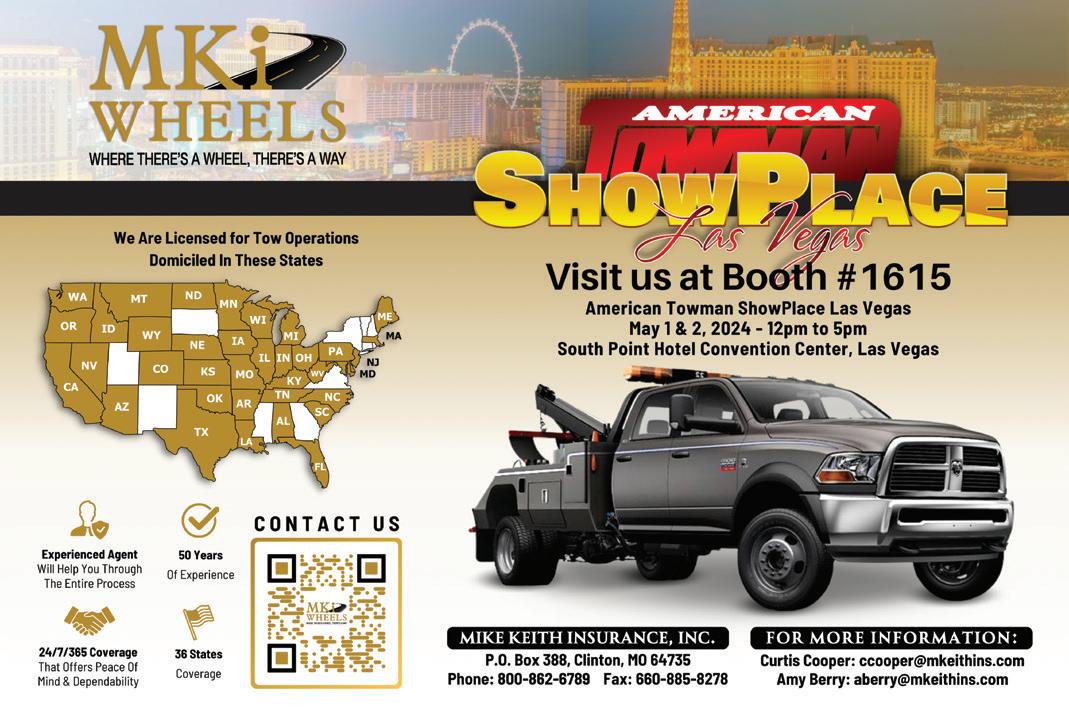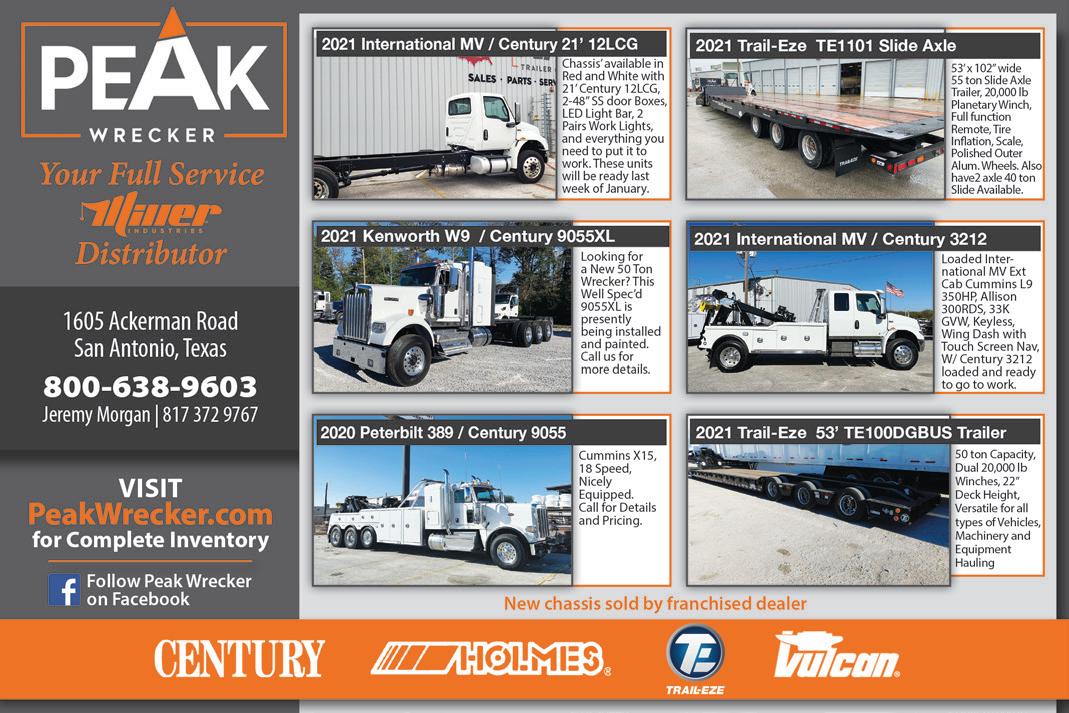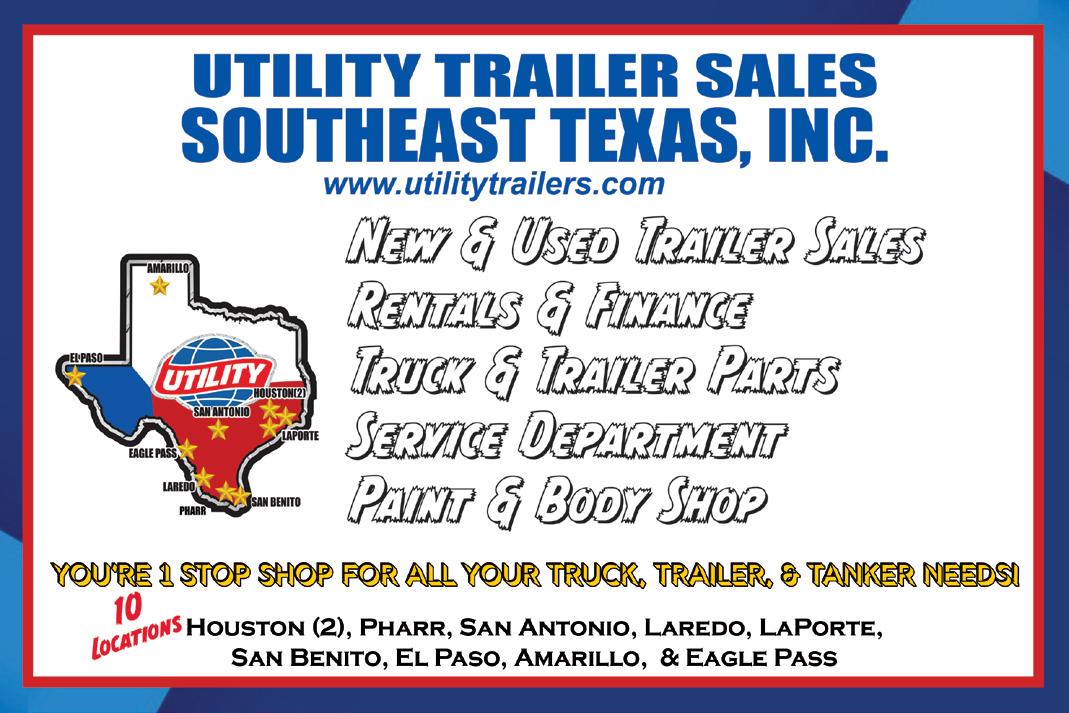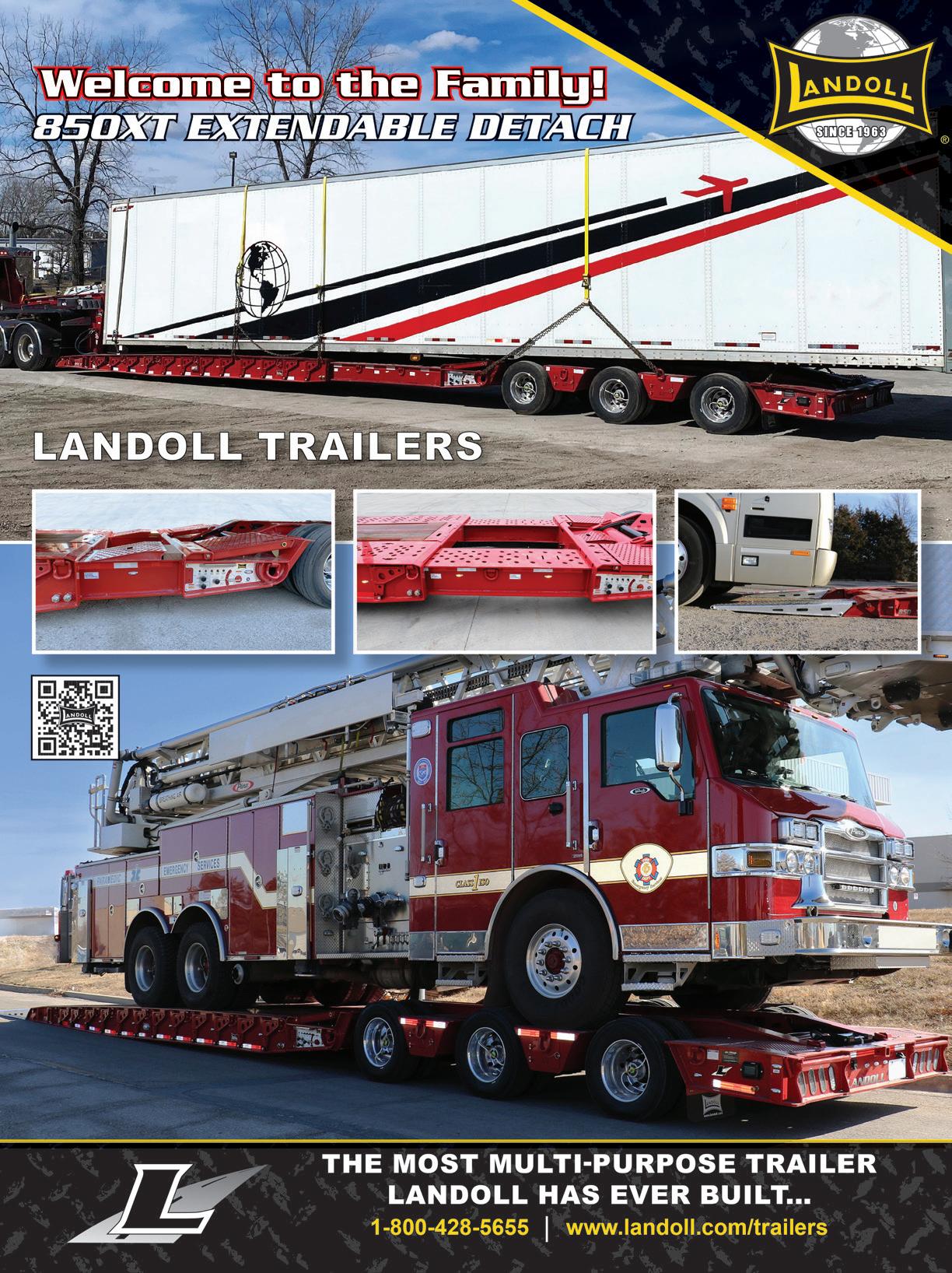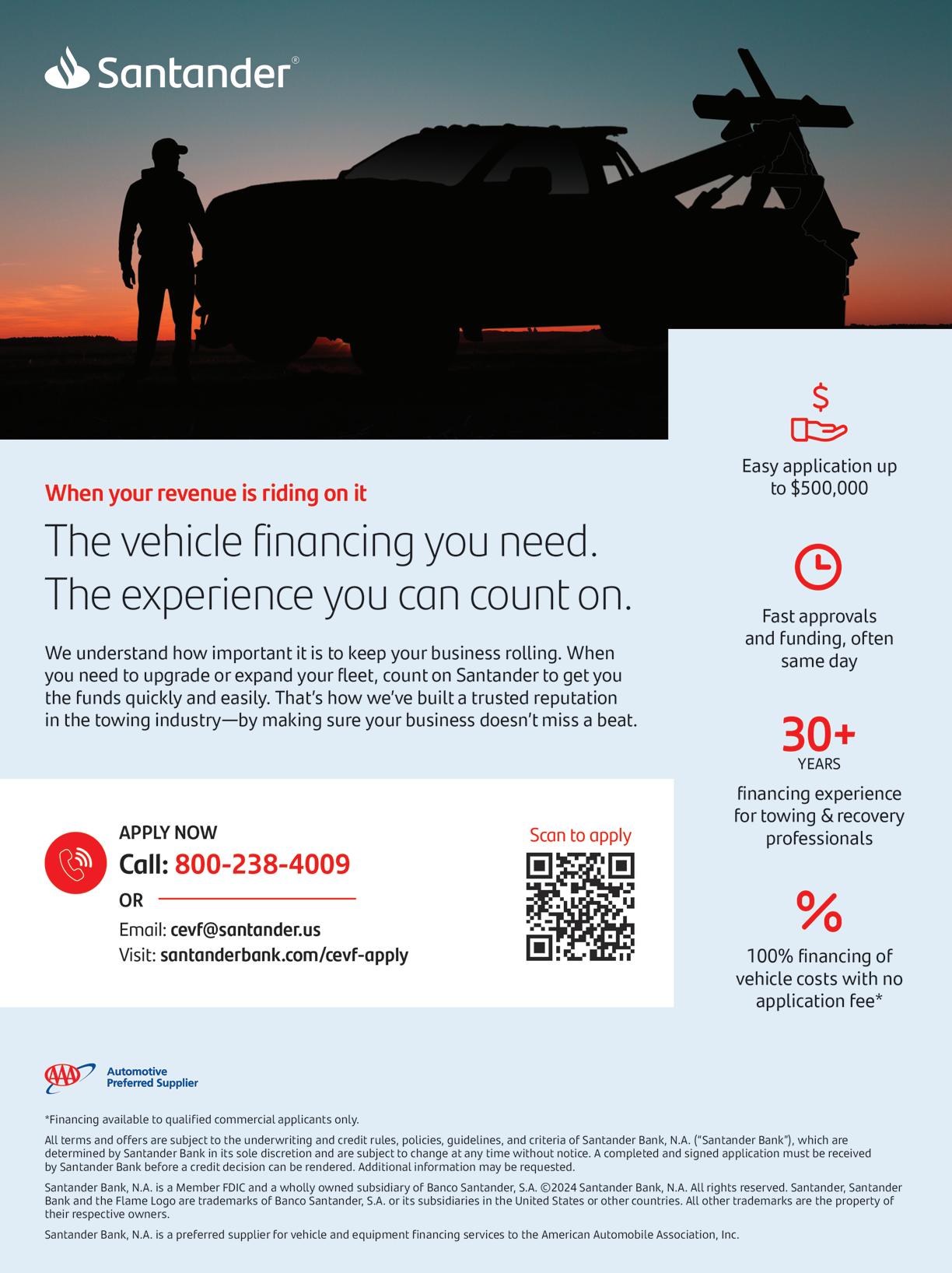






















 Dennie Ortiz Publisher
Dennie Ortiz Publisher
Operating a towing company today is not for the faint of heart. It requires grit and determination, along with a small helping of optimism and luck to be able to face the growing challenges to achieve success.
Towing rate increases continue to be an uphill battle as they mostly stay stagnant and are not commensurate with the quickly rising costs to do business. Now may be the moment to consider actions that you may not have thought of in less-demanding times.
Bear in mind that certain things just go together naturally, such as milk and cookies, a beer and a hotdog, and in the case of our industry—a towing operation combined with a repair or body shop. So, when looking at different avenues in which to grow your business, adding an auto repair or body shop to your current operations may just work for you.
In this issue, you will find two solid examples of how these services have natural symmetry and when joined, can be profitable and successful. You can find these stories both in our An American Towman department and our newly added Body Shop Opp department.
American Towman recognizes that these industries are mutually compatible, hence the formation of the ShopXpo trade show taking place alongside TowXpo during WreckWeek June 20-22 in Dallas/Ft.Worth.
Throughout WreckWeek, suppliers from both markets will connect with towing business and body shop owners on the exhibit floor, in conferences, and at networking events. Special seminars will be presented by DRIVE, a management training group specifically catering to the towing, auto repair and body shop businesses. Their personnel are uniquely suited to counsel you on the overall running of your business, while offering insights into the other service vocations you may be thinking of entering.
As you contemplate the future of your company, it would be helpful to read Brian Riker’s article on consolidation. Looking at our industry through a wide lens, Brian addresses this growing trend and whether it can be an opportunity or perhaps a problem for your company.
Bringing more knowledge to these pages is a new contributor, David Lewis, from the Emergency Responder Safety Institute (ERSI). Their mission is to teach responder safety to all disciplines that work the roadways. David easily breaks down roadside safety mistakes into five categories that every operator on your team should keep top of mind.
I hope you enjoy this issue and as always—stay safe out there!
 Steve Temple Editor
Steve Temple Editor
In going through all the articles in this issue, a recurring theme cropped up: Grit. The “Timber!” crane recovery not only required “enginuity” (field engineering and ingenuity), but also a lot of perseverance to overcome a number of unexpected challenges.
Our American Towman profile highlights the path of persistence often needed to succeed in the towing business. The same goes for our new department, Body Shop Opp, explaining how a towman was able to diversify, despite hitting some bumps in the road.
Note, too, the graphic on the My Baby wrecker, “23 1/2
Hour Service” which refers not to taking a brief work break, but putting in an extra-long day on a difficult recovery.
Even the Classic Wrecker feature described the extra efforts needed to both build and restore a ’56 REO.
The safety article on Avoiding Roadside Mistakes points out how dangerous a towman’s job can be, and what can help to prevent white-line strikes.
On a more mundane level, handling both winch maintenance and post-winter cleaning requires dedicated efforts to keep wreckers in tip-top shape. And, our piece on Consolidation highlights the value of resourcefulness in the changing business world.
It’s no secret that a towman’s life can be tough, but no doubt, you’re up to all the challenges.
Copyright ©2024 American Towman Magazine is published 12 times a year by American Towman Media, Inc.
Subscription: Single Copy: $10 1 yr: $60 – 2 yrs: $110 International: $75 & $135
question the integrity of a competitors product or service.


Fort Wayne Indiana towing companies spoke up at a city council meeting about their desire to be on the city’s police rotation, which has been held exclusively by Parker Towing since 2013, and whose contract is good through 2025.
Blue Eagle Towing Manager Mark Campbell said, “Our goal really isn’t for one company to have it; it should be on a rotation. There’s multiple providers throughout the city that could honestly provide a better service.” He says many places like Indianapolis have their contracts on a rotation.
Competitors say the rotation process would improve customer experience. “It gives everyone a fair chance at the market,” noted Riverside Towing Owner Ben McKean.
“Response time. I think that’s the biggest thing is response time,” Reichert-Knepp Heavy Towing Manager Christopher Harms said.
But Parker’s Towing attorney Andy Boxberger thinks that’s a bad idea. “It’s confusing. It’s different companies all the time. The police department’s not going to know who to call. Parker has invested in this community, they’ve invested in their infrastructure, and they have the means to provide the service,” Boxberger said.
Fort Wayne City Councilman Russ Jehl said, “There is a city contract that has not been put out for bid for years and been renewed and renewed. It’s just a bedrock principle of good government: you competitively bid contracts. That’s just part of good government, and then when there’s a concern like this, it just doesn’t look right. It doesn’t feel right.”
Source: wfft.com
Tow companies on New Jersey’s Roxbury police rotation may be seeing higher fees, raised significantly to align them with other nearby towns.
The Roxbury Township Council is on board with rate increases proposed by Roxbury Police Chief Dean Adone, who explained the need to increase the police towing rates: “When comparing the current Roxbury Police towing rates to other local towns, I found that our rates were considerably lower,” he wrote in a memo. “The last time we addressed the rate was on June 1, 2017.”

The township of Roxbury is on board for raising tow rates.
The chief noted that operating costs for towing companies have “gone up considerably” in the subsequent years. The proposed new rates are substantially more than those currently
allowed in the township. Currently, tow truck operators are paid $90 for the first mile or closer in Roxbury, and $3 for every additional mile. The new rate would be $155 plus $7 per mile beyond one mile. To store light-duty vehicles, the towing companies are now paid $25 to $30 in Roxbury. The new pay scale would increase that to $50.
Source: tapinto.net
Advanced Towing and a law firm with whom they are in contact with are critical of a new Virginia law to require a property owner or its agent to sign off on each tow before the vehicle is taken away.
Advanced Towing owner John O’Neill responded with the following comment: “The new law is a tool that serves no purpose but to place an onerous burden on the property owner and it places them in harm’s way.”
The law came into effect to combat predatory tow practices in Northern Virginia, where a second signature is not required. For the law to have any teeth, it would need to be adopted by the northern Virginia municipality of Arlington County.
In a letter sent by a law firm to Advanced Towing, O’Neill was
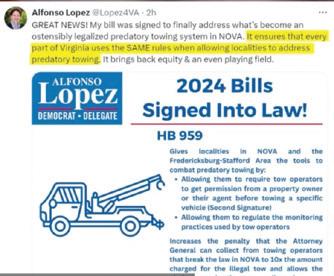
A new law in Virginia aims to require a second signature for private property tows.
reassured of the unconstitutionality of the law, claiming that it violates the rights of property owners who have contracted to remove trespassers, and that the law is impractical as well.
Source: www.wjla.com
Legislators in Washington State are passing legislation that would direct resources to study the fire hazards posed by electric vehicle batteries and establish best practices for firefighting, towing, storage and cleanup. Gov. Jay Inslee signed legislation from a bill that was sponsored by Sen. Jeff Wilson (R).

“Firefighting agencies are telling us fires are a small but growing problem as EVs win greater acceptance in the marketplace,” Wilson said in a statement. “Battery fires pose special hazards, like high voltage, intense heat, toxic fumes and a tendency to reignite. To douse a battery fire, you need a dozen times more water than an ordinary fire truck can carry. Quite often, firefighters just stand back and let EVs burn.”
Washington State Senator Jeff Wilson (R) sponsored the bill to study best practices in combatting EV battery fires.
During testimony before the Senate Transportation Committee, fire department officials said a typical fire truck carries 500 gallons of water, though it can take 12 times that amount to put out the typical EV battery fire. According to Wilson, the study should increase public acceptance of electric vehicles.
Source: chronline.com
Several cities are acting in response to increasing numbers of abandoned cars on their roadways. As one example, Columbus, Ohio towed 150 of them in one day, with the city’s mayor Andrew Ginther calling them a “blight,” and source of criminal activity. The initiative was precipitated by citizens expressing concerns about abandoned vehicles piling up on city streets.
“Neighborhoods throughout the city are saying we are tired of these junk cars,” Mayor Ginther stated. “Cars that have been abandoned on our streets,” Oakland, California, which is awash in abandoned vehicles, estimated to number 15,000, is working to tackle this problem as well. Their City Council unanimously voted to approve a measure that identifies available funding to hire multiple tow

companies and utilize Caltrans’ vacant lots for storage.
St. Louis, which is also seeing a rise in derelict cars, is raising the pay of towing contractors by 15%, and seeking to employ more of them to remove the vehicles.
Sources: the-sun.com abc7news.com fox2now.com
Several towing-related events in Wilmington, Delaware are coming to the forefront. One includes a proposed audit by city council of the city’s parking, booting and towing practices.
This comes on the heels of a lawsuit filed in 2021 claiming that Wilmington allows private companies to tow legally parked cars that have unpaid parking tickets totaling over $200, scrap the vehicles when outstanding debt is not paid within 30 days and keep the proceeds. That practice has garnered complaints by constituents, leading to the lawsuit that will be on trial in July.
Councilperson Shane Darby, who is sponsoring the resolution calling for the audit, said Wilmington’s practices seem “very unfair, confusing and very predatory.” She said the audit would look at both the costs as well as the practices of the city’s parking, booting and towing.
During the same meeting, Councilperson Letisha Bracy said she also has legislation proposed that would raise the unpaid ticket threshold for getting a boot from $200 to $500.
House Bill 351 codifies requirements for towing and storage of vehicles “without the consent of the owner or operator” and makes violations under the newly created chapter an “unlawful practice” that the state Department of Justice’s Consumer Protection unit can enforce.
www.delawareonline.com

The EZ vehicle recovery kit by TowToolz is designed for rotators to quickly hook-up and move vehicles, and serve as a replacement for 4-leg Grade 100 chain slings. The EZ’s quad legs design features a round master synthetic link on one end, and 1⁄2-inch soft shackles on the other, in order to easily attach to four rims of a vehicle. This product is ideal for lifts using vehicle rims’ pick points for greater load stability, with a max load capacity of 20,000 lbs. Also, it comes with a designed vehicle recovery function, a Working Load Limit, and serial number. In addition, the EZ’s XRP (Extreme Retainer Pulley) is a lightweight alternative to traditional snatch blocks and pulleys. Made of aluminum alloy, it’s sturdier and lighter so it can be used to increase pulling power or redirect the winch line. Note, however, that it’s intended for synthetic rope only, and is to be used with a soft shackle.
towtoolz.com
Vanair has introduced three versatile adapter kits for its Start All Jump Pack. This dual-voltage unit is a 12/24V, Lithium-Ion Jump Starter System than can now use NATO, Whitaker, Anderson, and standard alligator connectors. The kits are designed to quickly and flawlessly modify any Start All Jump Pack, enabling it to handle military, construction, mining and agricultural equipment, along with transit buses and a wide range of diesel engines. Rugged and compact, the handheld Start All Jump Pack can fit in tight spaces, allowing it to get between tightly-parked vehicles and go virtually anywhere a jump start is needed. The adaptor kits’ components are easy to install and significantly broaden the scope, scale, and utility of these lightweight and portable jump pack solutions.
vanair.com

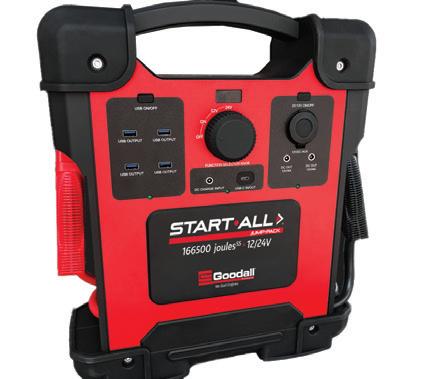
Looking to expand your tow company’s revenue? Check out iTow, which is seeking towers who share this company’s commitment to providing top-notch towing, recovery, and roadside assistance. By joining iTow’s network, towers can become part of a community of professionals that puts a priority on fairness, transparency, and customer satisfaction. There is no obligation, and no fees or spam, either. Benefits include free lead generation and same-day payouts, along with GPS-driven dispatching and 24-hour support. Towers can also view photos of the casualty vehicle before committing to a tow, and set their own prices.
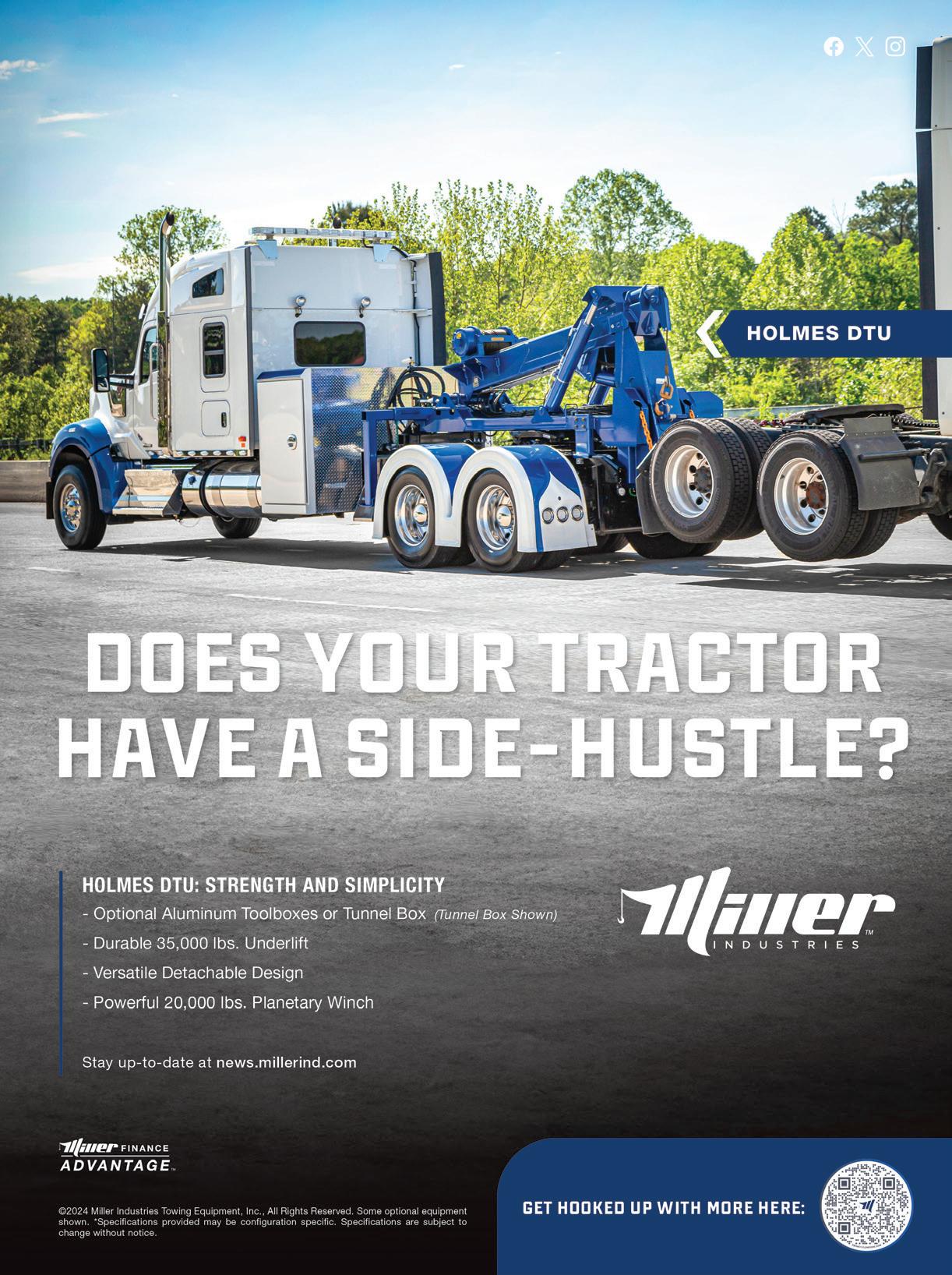

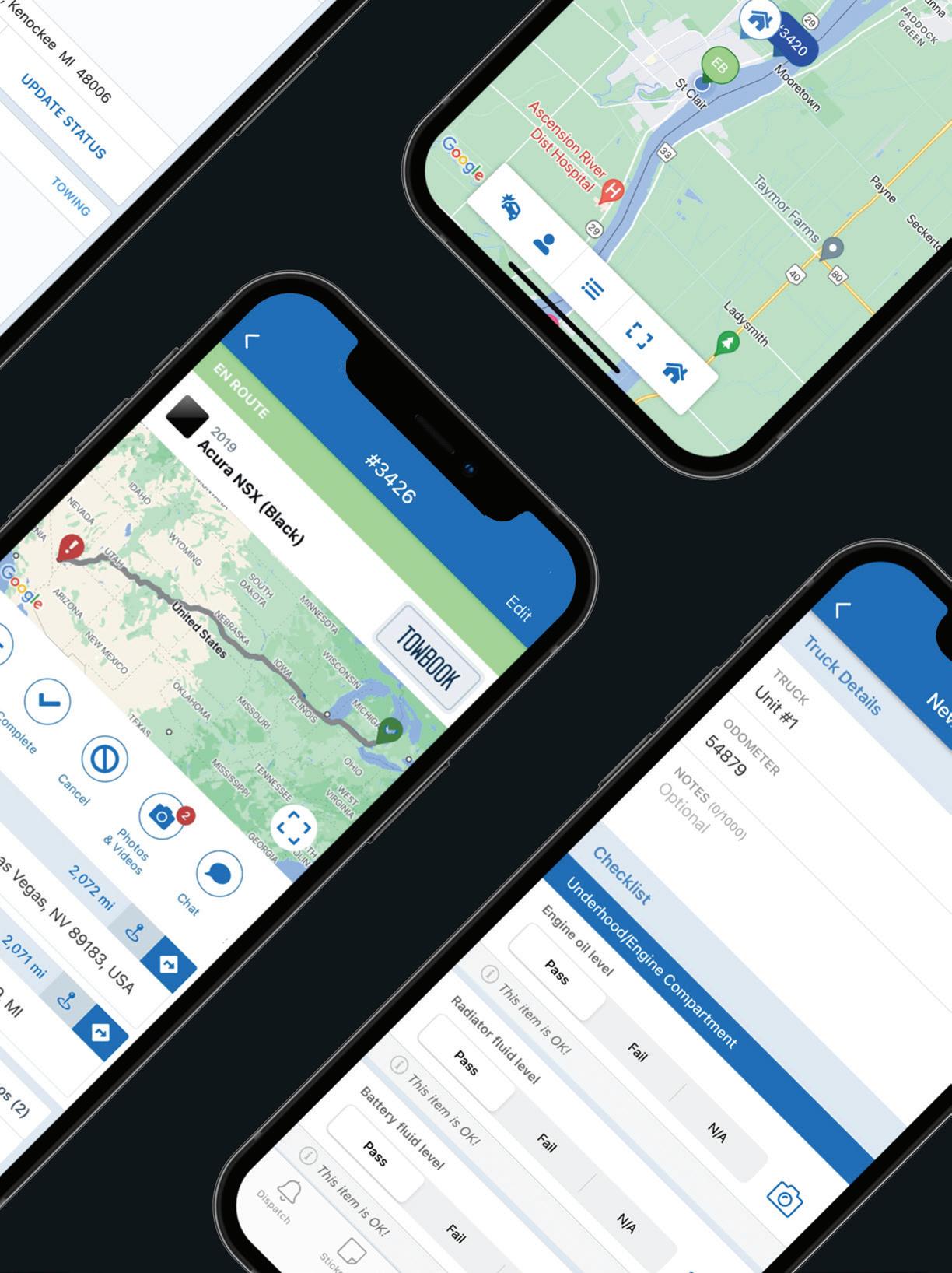


Consolidation is happening, ready or not. It is no big secret that business is tough, and the current economic, political, and social climates only make it tougher every day. Of course, change is inevitable. Time does not sit still and neither should any business. An organization can either adapt to the changing environment to stay viable, or be left behind and disappear. Success depends upon the ability to respond quickly and accurately to changing environments.
Looking back on the 30 years that I have been in this industry, my first wrecker was a Holmes 440 with a sling, and it was used well into the mid 1990s, on a daily basis as a primary response truck. Just a few short
years later, a wheel lift and car carrier were the industry standards, and much more modern than the trusty old Holmes. Progress was necessary in order to adapt to newer, unibody cars, along with the tow market’s demand for these types of trucks. So too, a changing industry requires this same ability to adapt.
Towing has historically been an industry full of bootstrapping entrepreneurs, and mom-and-pop outfits with little more than sheer willpower to survive. Most towers were either born into the industry, or became captivated by helping others in a time of need, and turned it into a career. Personally speaking, I still get a thrill when I get the chance to go on a live call and make someone’s day just a little bit brighter.
Given the people-focused nature of towing, some towers may wonder why consolidation is happening now. The answer is simple—money.
As pointed out by George Metos of Business By George (specializing in brokering the sale of towing companies), the advantages of consolidation are many. These include brand recognition, economic efficiencies, negotiating power, and attracting employees, among other factors. In towing specifically, the ability to share equipment between locations allows managers to spread their assets more effectively within a region. With all these advantages, it is clear that consolidation of the towing industry will continue.
In recognition of the push towards a global economy, and the effects that has had on supply chain and labor, we are seeing unprecedented increases in the cost of doing business. From labor to trucks and everything in-between, costs are out of control.
Political pressure is mounting on the industry to rein in fees and provide consumer protections. States are attacking the minimum wage, raising it to unsustainable levels in some areas. Other forces are at work to remove certain exemptions from the Fair Labor Standards
Given the peoplefocused nature of towing, some towers may wonder why consolidation is happening now. The answer is simple—money.
Act that have for decades helped motor carriers remain competitive with their wages without unnecessary regulations.
As a result, it’s likely that smaller companies will struggle to survive. It’s time to address the issues that are coming from external forces such as rate regulation, customer relations and many other operational considerations, and examine ways to move forward.
For many seasoned towers, consolidation is nothing new. Several companies tried it previously, with the most notable being Road One, backed by the Miller family of Miller Industries and United Road Towing. This independent consolidator grew from a familyowned towing company into a large player in the towing and auto transport industries, before splitting into separate operations and facing financial difficulties.
This consolidation effort wasn’t completely successful, though. The timing wasn’t right, and the management methods needed adjustment. They were just too innovative for the industry at ◀
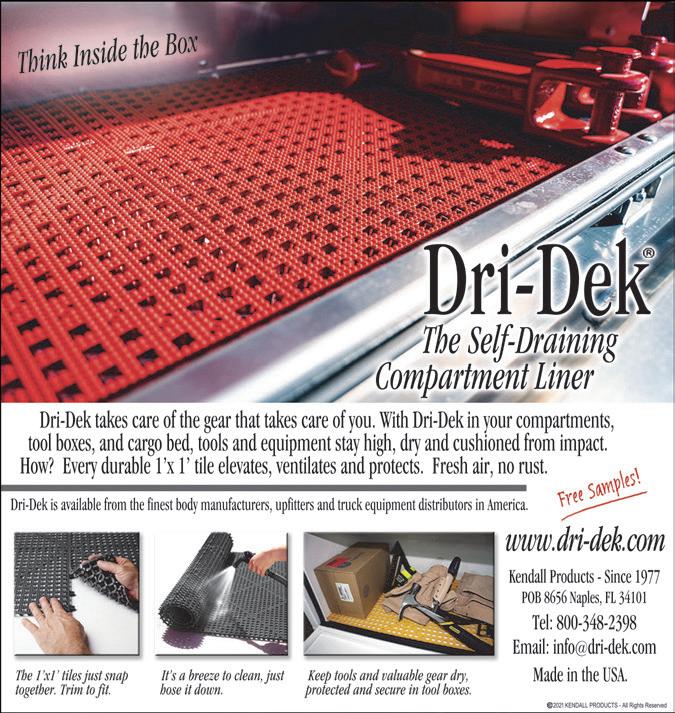
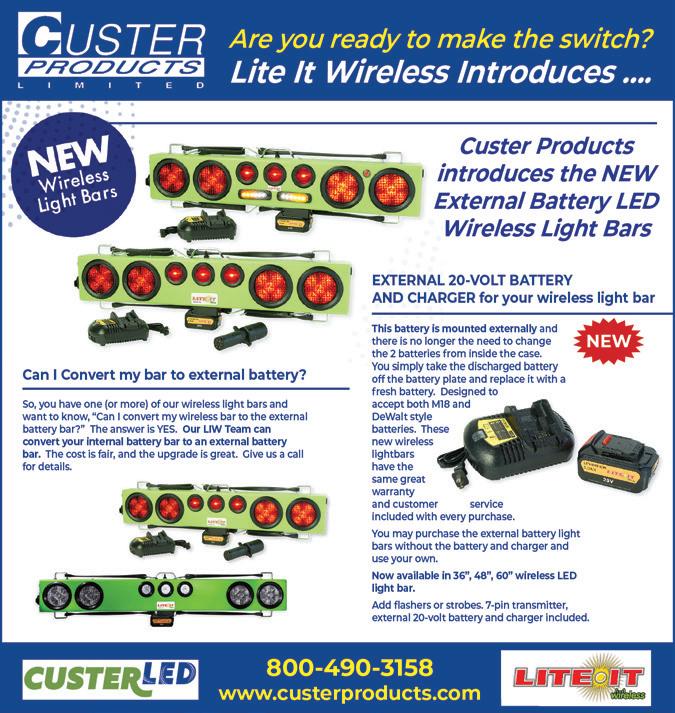


the time, trying to “corporatize” the operations. In contrast, many towers enjoy working for smaller towing companies with more relaxed atmospheres where they are able to build personal relationships directly with the owners. That is the polar opposite of a large corporation, and towers were just not ready for that in the 1990s.
Valuable lessons were learned from these initial failed ventures, and new approaches are being applied today for a much more robust consolidation effort, one that has a very high chance of success.
The short answer is the generational shift. Today’s workers do not tend to build a long career with any single employer. Depending on age group and occupation, the tenure at a single employer can be as short as a few months and up to just a few years. The U.S. Department of Labor average duration for laborers (which is what most towing company employees would be classified as) is only 2.8 years. Breaking this down further, older workers tend to stay with the same employer longer (9.8 years for age 55 to 64) than younger workers (2.8 years for age 24 to 35).
Gone are the days where an employee at a towing company would willingly work around the clock without days off, sacrificing time with family and friends in the name of retaining a job. The same holds true with owners.
As companies transition from generation-to-generation, many new leaders do not want to be married to their businesses, and instead are opting to invest in passive-income schemes or forgoing some of the profits to have more managers on the team to share the workload.
With this mindset shift, many companies already have in place excellent management teams
capable of running a towing operation successfully with absentee ownership. This was a critical failure with early consolidations, as the previous ownership would often leave the business shortly after selling. Or, if they remained on as a manager, they couldn’t effectively manage without being there 24/7, which led to burnout and failure.
Low-cost financing and trucks being readily available are no longer the norm. To survive today, a company needs readily available access to capital, and the ability to effectively execute long-range plans. Purchasing trucks to keep the wheels rolling now requires 12 to 18 months of advance planning, often tying up large amounts of capital or credit while waiting for the revenueproducing assets to arrive. Smaller operations simply do not have this type of financial reserve available. With the increased costs of equipment, it makes sense to share resources regionally. While this approach may not be an option for independent businesses, it can easily be accomplished with joint ownership of consolidated companies. The return on investment associated with a million-dollar piece of equipment must be substantial to make financial sense. Yet, many tow company owners make these purchases based on emotion, simply because they don’t want to let their competitors have any perceived advantage.
According to Metos, the favored target of consolidators thus far has been HD and Recovery towing. Why would investors focus on this type of towing? First, he points out that they can be very profitable, with higher average per-tow revenue, and recoveries generating tens of thousands of dollars. Sure, these companies have high CapEx (Capital
Expenditure) costs in wreckers, rotators, and class A drivers. But Metos notes that this same CapEx creates a barrier to entry to keep the competition to a minimum. We all know that wreckers are not getting any less expensive. Secondly, he adds that the network can attract a particular HD customer at many of the locations that they’ve built along the interstate. Consolidators want HD and Recovery companies that are placed strategically near the interstate, along with proven financial performance, a reasonably up-to-date fleet, and a good group of drivers. These attributes are unique to HD and Recovery towing and seem to make such towers more attractive to the consolidators.
Additionally, as the cost of business increases, so does the amount of business that is done
at a loss. Towing is one of the few industries that is expected to respond and provide service without concern for the customer’s ability to pay, and then have to fight with insurance companies and other third parties over what is deemed fair compensation. In some markets, more than 40% of all calls for service result in non-payment and disposal of abandoned vehicles, costs that are difficult for small family-owned businesses to absorb.
Regarding insurance, commercial auto premiums have recently skyrocketed, making it almost impossible for smaller outfits to maintain proper insurance coverage. The large companies, while still affected by this, have an advantage that allows them to pool their resources and self-insure against the average risk, or to join in the growing “captive” markets (explained below), again offering greater insurance coverage
at substantial discounts from what is available to a smaller fleet.
Insurance captives are not new, although they are exploding in popularity among many servicebased industries, including towing. The problem with captives, which can result in significantly lower overall cost for insurance, is having the excess capital to enter into one, and fund your first year of expenses. Unlike traditional premium-based products, with captives you are responsible for the overall losses of all members combined. In essence, the companies within the captive must be very well run and have safe operations with large cash reserves to cover the expenses.
Corporate companies with dedicated safety programs, inhouse trainers, and other resources to manage these risks, can thrive in captive insurance programs. Independents, not so much. ◀
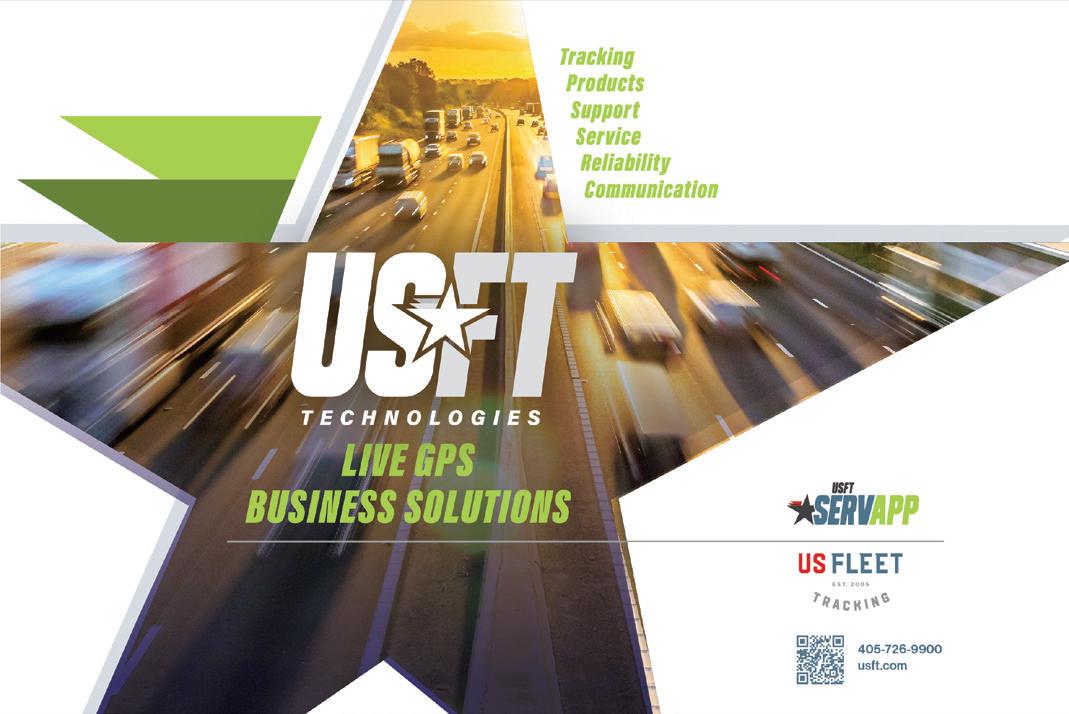
Call aggregators, also known as dispatch companies, have completely changed the automobile transport and general freight segments of trucking in much the same way as motor clubs and other third-party services (that provide work to local towing companies) have changed the industry. Gone are the days of a handshake and a meal with the Service Manager at the local dealership, meaning you would then get their tow calls. Today, many towers get their work from third-party services, and while they have their place within the industry, it makes it difficult for a small company to develop their own contracts.
This is especially true in the heavy-duty towing segment where trucking companies are also facing great consolidation pressures, reducing the number of large fleets available for a heavy-duty tower to
contract with. Add to this their own efforts to build service-provider networks and it will not be long before most heavy-duty work— including even emergency work like crashes—is controlled by in-house networks, and direct contracts between the major trucking companies, and many of the largest towing industry consolidators.
Metos observes that regional networks are being built by wellfunded, bright people who want to create a large geographical footprint. They value a good operation and the know-how of a seasoned staff. He feels that there’s no reason why these networks won’t succeed with their business plan. They have the capital to buy the private towing companies, acquire more trucks, compensate employees competitively, bring long-term financial security, provide flexibility in employee movement within the network, and increase the control of
their territories. The consolidators are good at building management infrastructure, which becomes necessary as a towing operation grows in size.
On the other hand, Metos notes that there are also many localized networks around the US and Canada where an operator has a handful of locations within a 100-mile radius. That’s not quite the same as regional consolidation driven by an investment group, which provides a more complete picture of consolidation. These localized networks may be attractive to the regional networks if they’ve built it wisely. Or they may remain private and thrive.
Given that the average towing company in the United States has five to seven employees, it is still an industry of small family businesses.
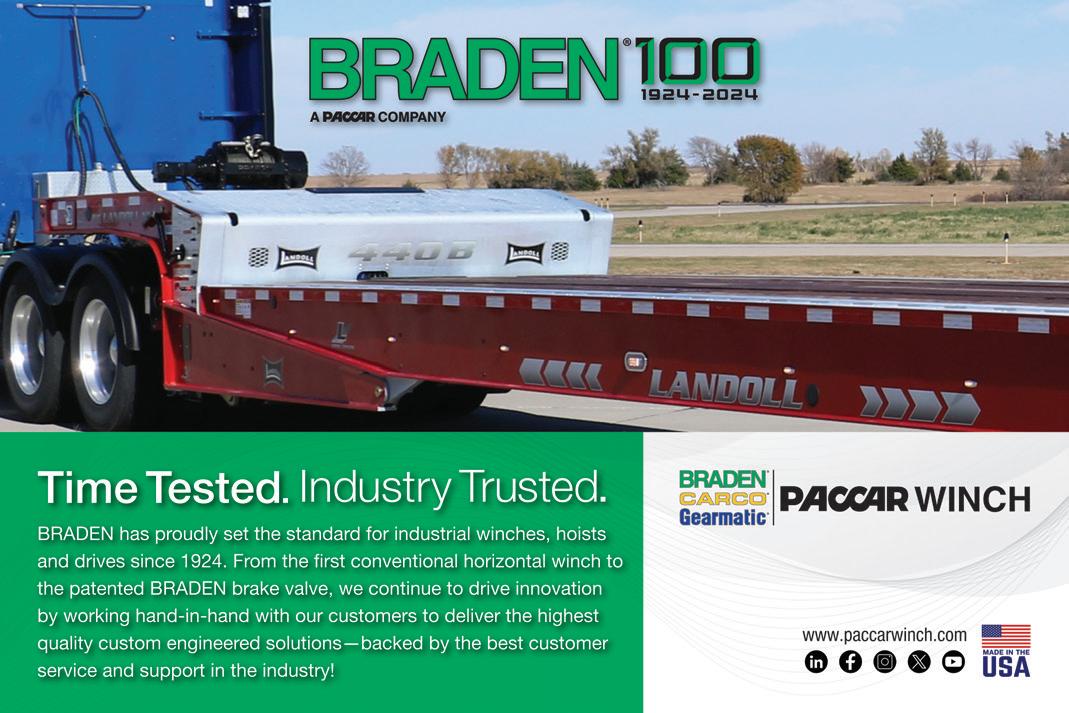
Consolidation will affect niche segments first, such as private-property impound and heavy-duty towing and repair services. These segments are appealing because they have large revenue potential and usually have commercial contracts that are transferable, unlike the light-duty segment of the industry where revenue sources are much smaller and less reliable.
The same can be said about collision centers. The key takeaway from consolidation in the repair industry is twofold. First, economy of scale makes an enormous impact on costs of goods sold and the bottom line.
Second, retain the real estate when the company is sold. This will create residual income regardless of how the new ownership manages the towing operations, and land can always be repurposed or leased to someone new. The best part about retaining land, it is in short supply, and we are not making any more of it.
Selling to a consolidator can be a viable exit strategy, especially when you don’t have anyone waiting in line that wants to assume the risks and responsibilities of owning and operating the family business.
Even so, Metos outlined some potential troubles faced when it’s time to sell for whatever reason. Businesses are valued in a few different ways, usually some combination of the value of the physical assets like property and trucks, plus proven income and profit, along with a bit of “blue sky” added to account for the name recognition and goodwill between a current business owner and their customers.
If a company’s books do not accurately reflect all the income and business expenses, a potential buyer will have to presume your company is worth less than you think.
“You don’t want to be in an undervalued position when it is time to sell, especially if the buyer is an absentee owner like a consolidation company or investment firm,” Metos points out. “They will need to make sure the company makes enough profit to pay a professional manager and still return a profit for their shareholders.”
He adds that owners commingle their personal and business funds, using company money to pay for personal expenses, instead of taking it out of the company as payroll or a dividend, which results in an inaccurate balance sheet when appraising their company.”
“These skewed financials can be very difficult to explain or correct if a quick sale is of essence,” Metos noted, “resulting in a greatly reduced sale price.”
To maximize the return on investment, consider some of these proven strategies, which are best ◀



applied three to five years prior to selling. The longer these measures are in place the better the return will be.
Begin with an accurate accounting of all business income and keep those funds separate from personal funds. Commingling business and personal funds is the equivalent of embezzling from yourself. Even sole proprietors should have, at a minimum, two separate checking accounts for business and personal funds.
Consolidation will have a greater impact on the shape of the towing industry more than ever before. Today’s big players, like Guardians of the Highway, and other lesser-known entities, have one thing in common. They are well funded, professionalmanagement organizations that understand how to operate in the current global economy.
Insurance reform, ever expanding consumer protection, and even major disruptions to how law enforcement selects service providers, are not major obstacles to these organizations because they have the manpower, expertise, and resources to either retaliate or adapt to the changing landscape.
The days of going it alone have been replaced by networking and association memberships. Power in numbers is critical to thrive in the current marketplace. Find positive ways to share resources among friendly competitors, or risk being forced out of existence when the larger, more resourceful companies enter into your market.



Editor’s note: The following experience is an all-toofrequent tragedy, one that might have been prevented by practicing the safety procedures highlighted below.

Early in the evening of July 21, 2020, Tyler Laudenslager, a 29-year-old tow operator with H&S Towing in Halifax, PA, responded to a call for assistance from another tow operator. This routine call changed the course of Tyler’s and his family’s lives in a way that couldn’t be anticipated. While working along the shoulder of I-78 in Bethel Township, PA, Tyler was struck and killed by a driver who was ignoring his surroundings. The driver was also found to have been driving while under the influence of drugs at the time of the crash.
Devastatingly, Tyler left behind his wife, newborn daughter, mom, sister, and many beloved friends. Sadly, this reality is not something unique to the Laundenslager family.
According to ERSI (Emergency Responder Safety Institute) 95 tow operators were struck and killed from 2019 to 2023—an average of 19 per year. Investigators often narrow down the cause of these incidents to five key factors:
As our nation’s roadways are busier and more congested than ever before, roadway incidents are just a part of everyday life. These incidents include vehicle crashes, disabled vehicles, debris in the roadway, or any other activity that impedes the normal flow of traffic. They pose a risk to the safety of both responders and the traveling public.
All incident responders, including law enforcement, fire departments, Emergency Medical Services (EMS) units, and towing and recovery operators must practice safe operating procedures. The core principles of Traffic Incident


Management must be studied and practiced by every responder group.
Traffic Incident Management (TIM) consists of a planned and coordinated process to detect, respond to, and clear traffic incidents so that traffic flow is restored as safely and as quickly as possible. The goals of the TIM program include improving the safety of responders and road users. It is recommended that all roadway responders complete a nationally recognized TIM training course. Some states even require TIM training for specific responders, including tow and recovery operators.
A TIM training course consists of modules covering recommended practices for scene assessment, safe vehicle positioning, on scene safety, traffic flow management, special considerations, and clearance and termination. The most effective training is conducted with a mixed responder group consisting of law enforcement, fire/EMS, towing & recovery, and service patrol personnel all training together. Integrated training
allows each responder to gain a better understanding of the other response groups’ actions, needs, and concerns when operating at an incident scene.
Each state has assigned a TIM coordinator that can bring training to your local area. When possible, the training should include both classroom sessions and outdoor practical activities. Where classroom training is not possible, online training is available through the Federal Highway Administration (FHWA) or through the Responder Safety Learning Network (accessible through learning.respondersafety.com).
Upon arrival at an incident scene, the responding unit must:
a) Position their vehicle(s) in a manner that protects the responders that are performing their duties.
b) Protect road users traveling through the incident scene.
c) Minimize disruption to the flow of traffic.
d) Use appropriate temporary traffic control devices (e.g., cones, flares, lights, signs) to establish a Traffic Incident Management Area (TIMA).
e) Employ appropriate temporary traffic control devices to divert traffic away from the incident scene.
When multiple units are deployed to an incident scene (e.g. fire department, EMS, and tow trucks), the largest vehicle should be positioned as a blocking vehicle to protect the others working at the incident scene. Solo responders should establish a TIMA before beginning tow operations. When traffic conditions involve too much risk, contact the dispatcher and request a law enforcement or service patrol unit assist with
The Cumberland Valley Volunteer Firefighters Association (CVVFA) was formed in 1901 by fire companies across a four-state region to address challenges related to operations and training. Today, CVVFA members span across the U.S., and continues to focus on responder safety. In 1998, the CVVFA organized the Emergency Responder Safety Institute (ERSI) to address the challenges of operating incidents along the nation’s roadways. The ERSI has developed many technical reports addressing roadway safety, and hosts the Responder Safety Learning Network (RSLN) with a large collection of online learning modules to enhance safety for first responders when working roadway incidents. The RSLN can be accessed online at learning.respondersafety.com. Once registered, you may complete free training through any of 48 learning modules. The following are samples of training modules of particular interest to Towing and Recovery operators:
• The First 15 Minutes at Roadway Operations
• Advanced Warning
• Fire Service Collaboration with Towing and Recovery Operations
• Move It or Work It
• See and Be Seen: Emergency Lighting Awareness
• Traffic Incident Management on Rural Roads
• Traffic Incident Management: Model Practices and Procedures


scene safety.
Effective traffic control equipment should be carried on the tow vehicles so that it can be quickly deployed when arriving at an incident scene. Joint planning and training with fire, law enforcement, and service patrol units will help establish partnerships to support each other at an incident scene.
When working a roadway incident, always provide sufficient warning to oncoming vehicles that is clearly seen by approaching traffic. Visibility means having your vehicle clearly marked as a response vehicle, emergency lighting activated, and all roadside workers wearing appropriate highvisibility apparel.
A study conducted by the ERSI demonstrated that flashing lights alone do not provide enough warning to approaching vehicles. Absent of any marking or warnings, you appear as just another vehicle on the roadway and the approaching traffic may not even be aware that you are stopped.
The Manual for Uniform Traffic Control Devices (MUTCD) requires that, “all workers, including emergency responders, within the right-of-way of a roadway who are exposed either to traffic (vehicles using the

roadway for purposes of travel) or to work vehicles and construction equipment shall wear highvisibility safety apparel (HVSA).”
HSVA consists of a combination of fluorescent and retroreflective material to increase the visibility of workers along the roadway. Retroreflective material helps identify the wearer during nighttime activity, and fluorescent materials helps identify the wearer during daytime activity. It is essential that the apparel is both retroreflective and fluorescent.
It is also important to properly maintain apparel and replace it when it has become worn and dirty. When the apparel becomes deeply soiled, it loses its visibility features, and can no longer be seen by approaching traffic. The more visible the responder, the better the chance that the traveling motorist will slow down, move over, and avoid entering the work area.
As noted above, vehicle markings and lighting are important for warning motorists that your vehicle is working a traffic incident. Warning lights on vehicles are often governed by state laws that mandate their use for certain incident types, and also specify allowable colors for different types of response vehicles. As the standards and the technologies have evolved, response vehicles have been equipped with more lighting. The question to ask is “How much is too much?”
The introduction of LEDs provides both new opportunities and challenges for tow vehicle lighting. LEDs emit higher levels of lighting while using much less power and drain on batteries. These lights may be very effective during both daytime and response mode. However, when a tow vehicle is parked alongside or on a roadway at night, the lights may be blinding to approaching motorists, and distract them from safely negotiating past the incident scene.
A technical report, developed by the ERSI, determined that excessive lighting often contributes to secondary crashes and is a leading cause of struck-by incidents and responder injury or death. For safe operation on roadway incidents, operators should use only enough lights to provide adequate warning to approaching traffic.
Forward-facing lights should
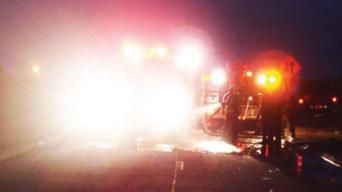

be kept to a minimum so as not to confuse vehicles coming from the opposite direction of the incident.
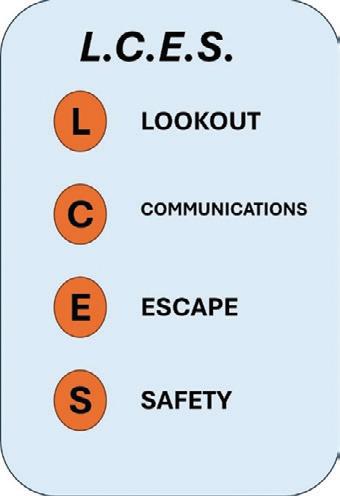
Work lights should be sufficient to light up the working area, but not directed towards oncoming traffic, if possible. Reduce the intensity of lighting so that it does not blind approaching traffic. Flashing lights should be of an alternating pattern, and strobe lights should not be used for on-scene operations.
When operating at an incident scene, tow operators must always maintain situational awareness. Continually ask yourself, “What is the approaching traffic doing? Are both my vehicle and personnel at risk? Are adequate advanced warning and temporary traffic control devices in place?” Failure to maintain awareness on scene makes the operator a target for distracted or confused drivers.
When possible, consider using a load-and-go or quick-clearance operation to rapidly move the vehicle to a safe area, and then secure the load to the tow vehicle. This approach gets you out of the danger zone, where there is an increased risk of getting struck and injured or killed. If your wrecker has dual controls, use the nontraffic side controls to keep you away from oncoming vehicles.
Practice the acronym LCES: Lookout, Communications, Escape, and Safety.
Whenever possible, have a second responder serve as a Lookout for advanced warning of oncoming traffic, and quickly alert you to potential hazards.
Use Communications to alert police and fire units of the need for lane closures and temporary trafficcontrol measures.
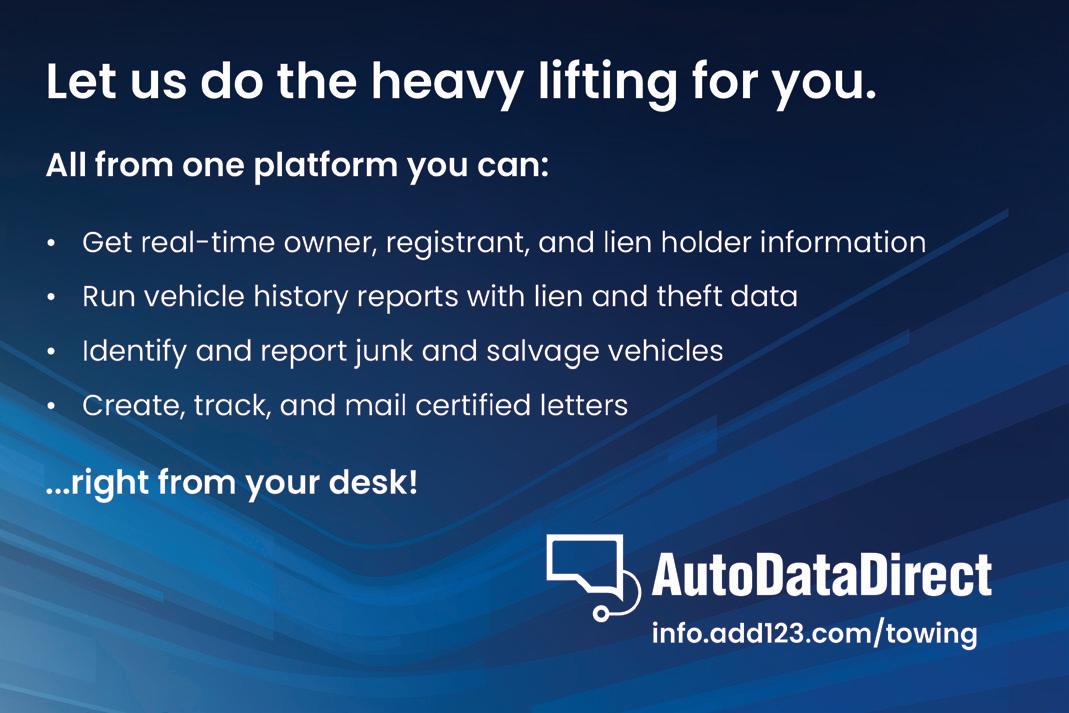

Plan two Escape paths that allow you to quickly move away from approaching traffic should they enter your work zone.
Practice Safety, including
identifying a safe area where a casualty vehicle can be moved to after a load-and-go operation for securing the vehicle for transport.
Each day, towing and recovery
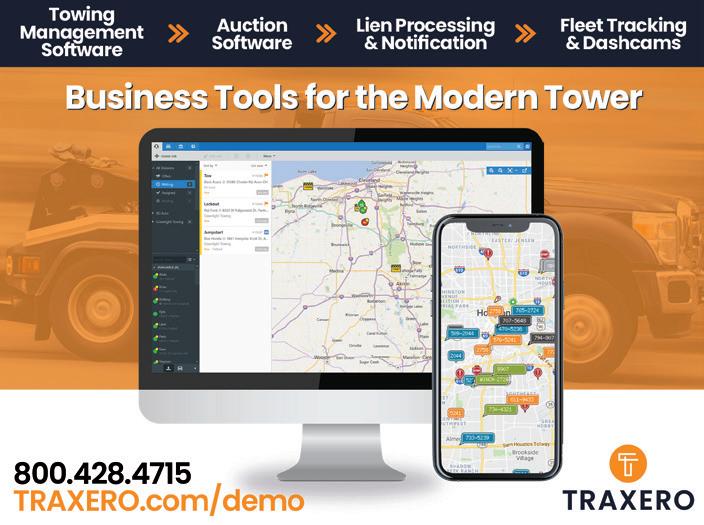
operators, like all other roadway incident responders, are at risk when working along the nation’s roadways. It is critical that they employ best practices and operational procedures—making themselves visible, and working quickly to minimize both their own exposure as well as traffic disruption. By doing so, there is a better chance that everyone will return home safely.




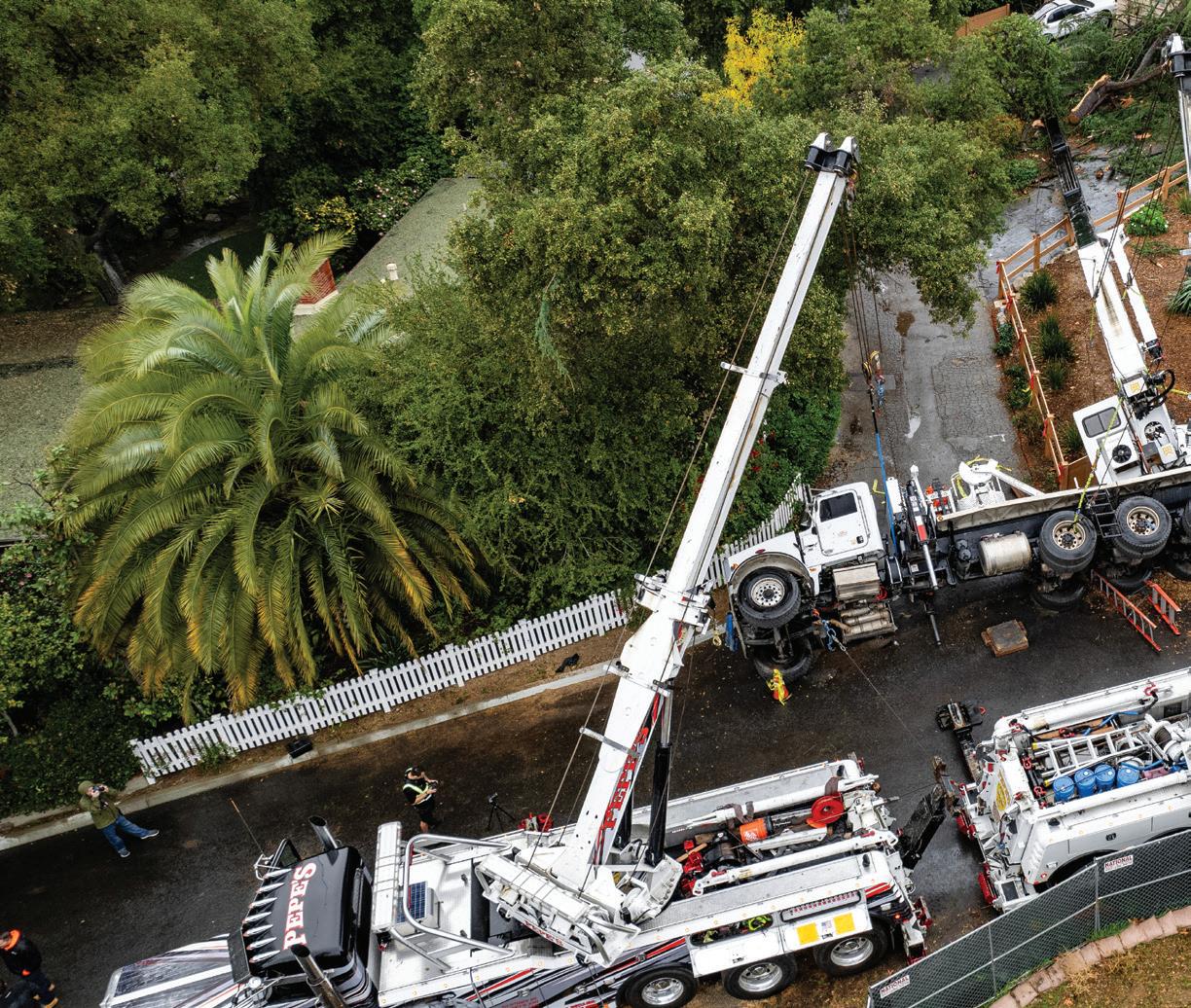
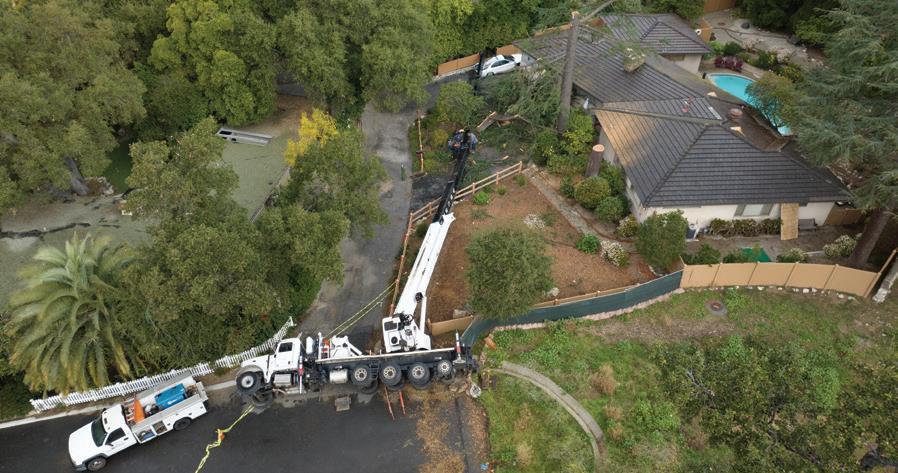 By George L. Nitti
By George L. Nitti
Beware. Not only of falling trees, but crane booms crossing your path. They both can make a lot of commotion, as Pepe’s Towing and Recovery found out.
2020 Peterbilt
1150 Century Rotator
2019 Peterbilt
1075 Century Rotator


“There was no room to put the rotators. The working area was horrible.”
Trimming the tops of tall trees is perilous work. Particularly if a 122-foot crane is on scene and flips from the weight of its extended boom, as a result of failing to employ outriggers that would normally provide stability.
With no job too difficult, Pepe’s was called on scene to Altadena, CA in early January to upright the toppled crane. They brought in their Century rotators, a 2020 1150 and a 2019 1075, also known as Big Flipper and Hulk, both of which sit on Peterbilt 389s. The operation was led by tow operators Joshua Acosta and Alex Hernandez.
“It was a long day,” grimaced Acosta. “We had a horrible working space and it started to rain on the private, residential road where the casualty lay. We didn’t expect that. You can imagine how slippery a wet crane is.”
Scoping out the scene the night before, Joshua and Alex arrived 8 a.m. sharp the following morning to execute their plan. But you know what they say about “the best laid plans,” and this one was no exception.
With no way to access the crane but through a narrow road, upon their initial approach, they encountered 3000-pound cut logs strewn across the roadway, which needed to be removed before they could get to the casualty.
“We were previously reassured by the crane company that those cut logs wouldn’t be there when we arrived in the morning,” Acosta noted. But they were still there, so the towers spent about 45 minutes removing them. The next headache involved positioning of the rotators in relation to the crane.
“It was an issue,” related Acosta, “for fear of hitting our trucks. We couldn’t get in front of it or to the side. You couldn’t park away from it. There was no room to put the rotators. The working area was horrible.”
The outriggers on the crane didn’t work either, which only further complicated the job.
“They were shot,” Acosta noted. “The recovery was horribly complicated in every sense of the word.”
How then would they upright the crane, with its boom fully extended sideways, laying flush to the ground? Along with its end slammed onto a vehicle that now lay in ruins? They determined that the



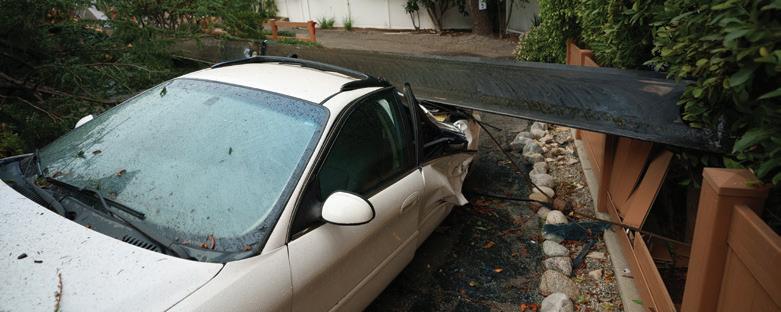
The crane’s boom had to be winched back by the rotators into an upright position with it fully extended. To gain more leverage, Pepe’s hooked up to holes in the middle of the crane, pulling up on it with their rotator, and then rerigging halfway up to gain further leverage to pull the crane back over.
best plan was to use the rotator to winch in the boom to retract the crane, but adding to their frustration they soon discovered that the crane’s boom would not retract. So, they had to upright the crane with the boom extended. Acosta explained the difficulties of this approach.
“When you lift something heavy like a tanker, the weight is always concentrated. It’s like picking up a 10-pound dumbbell. If you lean over and pick it up, it’s no problem, but if you attach a 20-foot rod to a 10-pound dumbbell, it’s much harder to lift. That’s how leverage works. That’s what we were dealing with," Acosta pointed out. “The job would have been much easier to complete if only their boom had retracted, but that was a no-go, most likely caused by an electrical short."
To gain more leverage, Pepe’s hooked up to holes in the middle of the crane, pulling up on it with their rotator, and then rerigging halfway up to gain further



leverage to pull the crane back over.
“Once we got it up, the customer was adamant that the engine would start up and the boom would retract, but once again, that was not the case,” an exasperated Acosted stated. "We had to crib the outrigger forcefully and extend it out until they could fix it."
Fortunately, Alex is a mechanic and knew how to bleed outriggers in order to get them to move. After waiting a couple of days for a crane specialist to get the boom to retract, Pepe’s returned to the scene, and this time easily towed it back to their home base.
“Alex and I made this work because we understand as rotator operators that you need to adapt if your original game plan doesn’t work,” Acosta said. “You have to have backup plans, and back-up plans for those back-up plans.” And don’t forget to be prepared to yell “Timber” too!
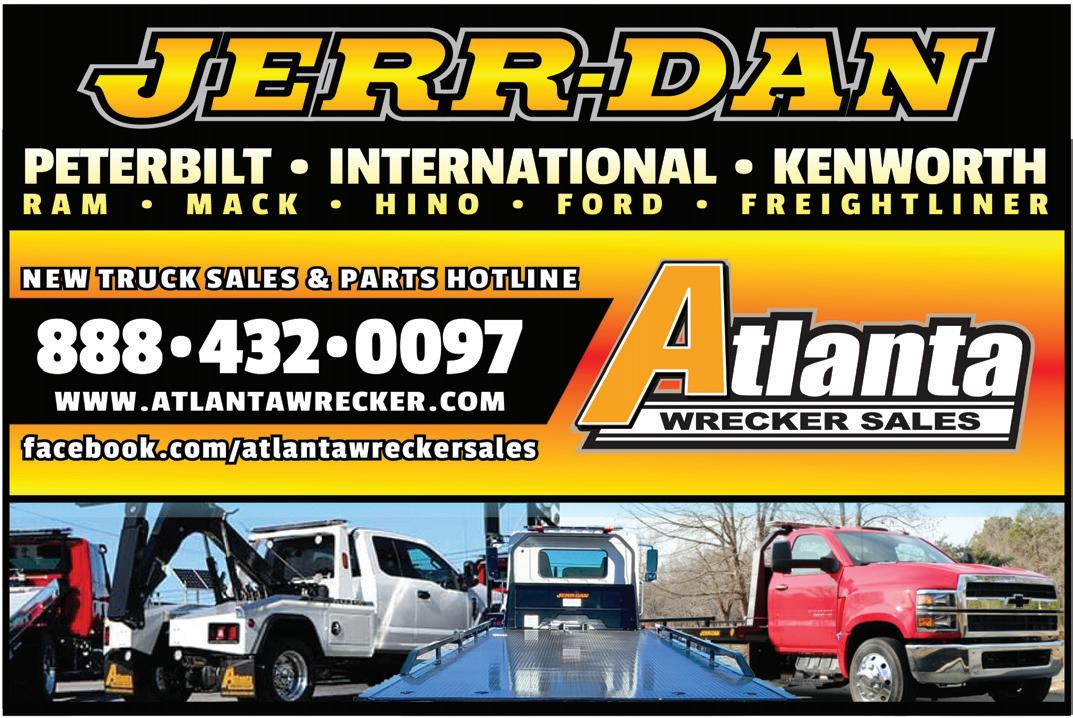

Exhibitors as of April 12: For up-to-date roster go to ATShowplace.com
*Supplier names in bold are display advertisers in this issue with their booth and ad page numbers cross-referenced.
A-P Equipment Financing
Access Tools Booth #1008 - pg. 61
Advanced Track Solutions
Agero
Alliance Funding Group
Allstate Roadside
Alt Enterprises
American Towman Magazine Booth #108
American Transportation Insurance Group
American Wrecker Sales SC
Anchor Graphics
Apache 2 Way
ARI-Hetra
Arizona Prof. Towing & Recovery Association
Arroyo Tires
Ascentium Capital
Auto Data Direct Booth #1106 - pg. 30
Automobile Club of Southern California
Azuga, A Bridgestone Company
B/A Products
Beacon Funding
Big D’s Fabrication Booth #729 - pg. M76
Bissell Commercial
Blue Star Customs
Chergey Insurance
Collins Dollies
Commercial Best Insurance Services
Copart Transportation Booth #J4, 912 - pg. 3
CTTA/ERSCA
Curbside SOS
Curtis J Vernon Insurance Agency
Custer Products Booth #1223 - pg. 17
Delta Absorbents of America
DewEze Mfg.
DRIVE
Dual-Tech Wreckers & Carriers
Booth #604 - pg. 34
East Coast Truck & Trailer Sales Booth #1025 W77
Emergency Road Service Coalition of America / ERSCA
Energy Security Agency
Environmental Chemical Solutions
Epulse
Expo Enterprise
FCar Tech USA
Federal Signal
First Business Bank Booth #819 - pg. 65
Five Star Registration
FleetNet America
Freeway Service Patrol (FSP)
Fullbay Repair Shop Software
G.L. Anderson Insurance Services
Gaston & Sheehan Auctioneers
GEICO
Golden West Towing Equipment
Greasweep
Gulf Atlantic Supply
Guttman Energy
Haas Alert
Healthy Feet
Huntington Bank
Hydraulic Shop
i Buy Remotes
IAA Holdings
ICW Group Insurance Booth #120 - pg. 55
In The Ditch Towing Products
Isuzu Commercial Truck of America
Booth #119 - pg. 25
iTow
IWS
James Parker Insurance JB Towing
Kalyn Siebert
Khasim Insurance Agency
Booth #1000 - pg. 67
Konnectronix
Landoll Corporation Booth #1517 - Inside Back Cover
Lien Enforcement
Lodar USA Booth #1122 - pg. 63
Lubnau Gonzalez Insurance Agency Booth #719 - pg. W76
Lynch Denver
Magnet Works
McCandless International Trucks
MIDCO SALES
Mike Keith Insurance Booth #1615 - pg. W80
Miller Industries Booth #418 - pgs. 13, 49
Mobile Road Service Solutions
Mobile Video Computing Solutions
Murphy Bank
Murphy’s Towing
National Automobile Club
Nevada State Tow Association
Nite Beam Products
NRC Industries Booth #1202 - pg. 29
NSD +Questx
OMG Tow Marketing Booth #1006 - pg. 52
OnCallGPS Video
OnPoint AVL & Navigation
Peak Auto Auctions
Peddle
Penny Pockets
Phoenix USA
Professional Dispatch Service Booth #100 - pg. 18
Pruuvn
Ranger SST
RC Industries
RealWheels Corp.
RLX
Roadside Protect
RoadSync
Robertson Ryan Tow Truck Insurance
Robinson Oil
Rocky Mountain Wrecker Sales
RP Recovery
Rush Towing Systems
Safety Vision
Salvato
Santander Bank Booth #510 - Back Cover
SDMO Nation
Sea Crest Insurance Agency Booth #918 - pg. W82
Service Member Data
Southern California Tow Equipment
Specialty Vehicle Equipment Funding Group
Steck Manufacturing
TEC Equipment Booth #210 - pg. 21
Telecom Tech Solutions
The Exchange | 24/7 Dispatch
Tie 4 Safe
TJR Equipment
TKO Solutions Tire Tools
Todd Equipment
TOMAR Electronics
Tow Industries
Booth #217, Hallway, Outside - pg. W80
Tow World
Towbook Management Software Booth #1102 - pgs. 14-15
Towing Dispatch Services
TowToolz Booth #117 - pg. 59
Tradeline
Trail King Industries Booth #1604 - pg. 57
Trail-Eze Trailers
Traxero North America Booth #904 - pg. 32
Truck Body Sales
USFT Booth #508 - pg. 19
Utah Professional Towing Alliance
Verdant Commercial Capital
Warrior Winches
Wasatch Truck Equipment
Wellnex Group
Whelen Engineering Co.
Whiterail
Will-Burt Booth #1215 - pg. 57
WorkWear Outfitters
WreckMaster
XINSURANCE Booth #1213 - pg. 51
Ynot Services
Zacklift International
Zellner Insurance
ZeroFee Commerce
Zip’s AW Direct Booth #1119 - pg. 27


Chase Clough of DRIVE has a wide range of marketing knowledge, including content creation, writing, and editing across all social platforms. She has recently graduated with her Masters in Marketing Management & Communication from Florida State University. Chase uses the skills she’s developed professionally and academically in her position at DRIVE.

Recruiting skilled staff is no simple task, and obviously keeping them happy with their work is important as well. Tow managers often share these concerns, so here are a few practical suggestions.
Think of a sports team, and how their coaches all have a collection of plays and other tactics. Their playbook is critical to a the team’s success, and the best coaches likely have the most detailed books.
Similarly, recruiters must also maintain a detailed ‘playbook’ (aka “manual”) of the company’s policies and procedures. This manual will ensure that everyone, including company owners and managers, are held to the same strict standards.
In addition to the company's policies, procedures, key towing safety practices, and onboarding files (i.e. W-4s, I-9s, etc.), the manual must also include benefits enrollment information, employment contracts, and team communication policies.
Company manuals help keep an eye on KPIs (Key Performance Indicators) which are essential to ensuring that the company remains on track toward reaching established goals. A “playbook” is also a great place to keep a detailed record of any milestones. Whether they be monthly, quarterly, or yearly, they should be easy to find. By having goals clearly displayed, everyone is kept accountable.
A vital and often overlooked practice is documenting thorough job descriptions. Every position in a business should have a detailed description of the responsibilities and expectations associated with the role. As Erkan Ozbardakci, a DRIVE Business Coach, says, “A job description tells a team member what the position is all about and how it fits in with the rest of the company.”
An enticing job description can also help recruit top talent. When a prospective

During this year’s annual DRIVE EXPO, Erkan Ozbardakci will be delivering a workshop where he will discuss all of these factors and more. He’ll detail the exact ways you can hire top talent and create a top-notch workplace in “Building A Winning Team.” Register today at drive-expo.com!
hire easily identifies their daily responsibilities, they can more easily envision themselves at that job.
A job description also identifies company benefits, such as paid timeoff, sick days, healthcare programs, or any other aspect of a tow business that sets it apart from the competition. For example, if there’s a team meeting every week with a free lunch, add it to the job description so future team members get a feel for the priorities and business culture right from the get-go.
What are some other ways in which tow businesses differ from one another? While many towing operations open at 7:00 a.m., another operation might want employees to show up 15 minutes earlier. Unless that expectation is documented and communicated to the team, the new hire they will take direction from whomever is their superior.
It is imperative to inform all new hires of the company’s standards on their very first day of employment. Furthermore, have them review and sign-off on their specific job duties and responsibilities, including how tow operators are expected to ◀
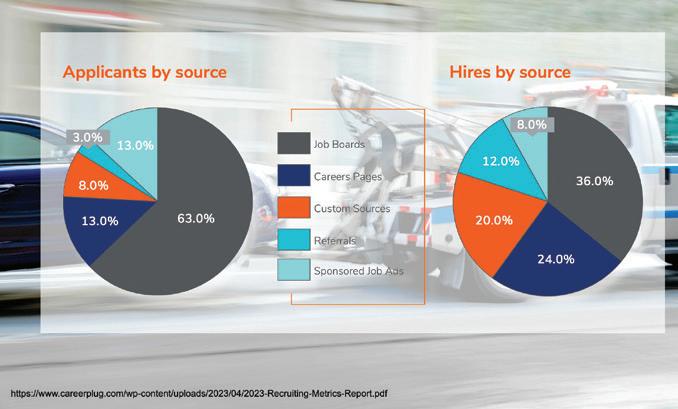
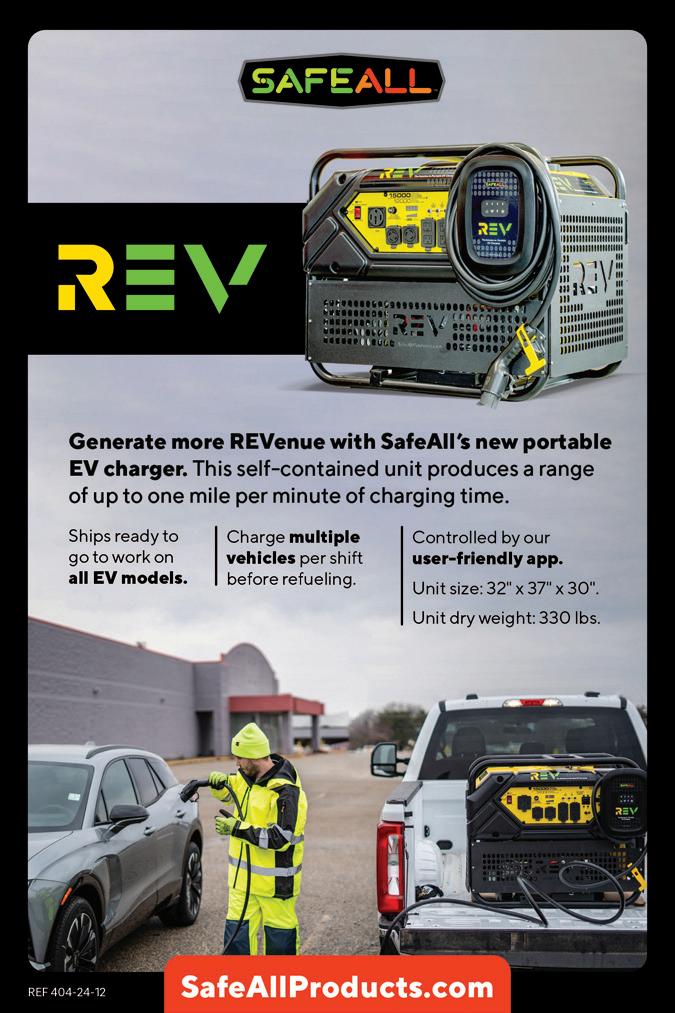

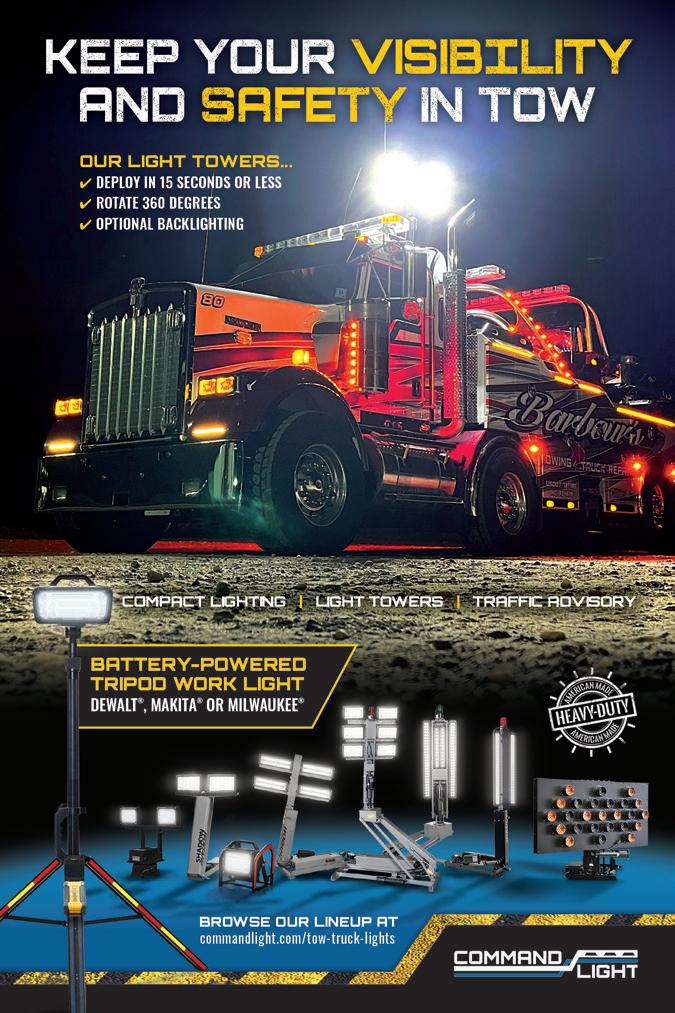
care for their tow truck, and the safety attire they are required to wear on the job. This also provides them with an opportunity to ask questions about any company policies which might not be abundantly clear.
Here are a few additional key aspects to cover:
• Is a four-day workweek in place?
• Does overtime occur regularly in this role?
• Who does the new team member report to?
• If they have an issue or question, who should they speak to?
• Are employees expected to bill a certain amount of hours, or meet specific quotas?
Once an employee is hired, it is imperative to check in with them regularly. Monitoring their progress is an excellent way of preventing poor work habits from developing. Asking if an the employee needs anything, and providing them with extra training on towing and recovery methods is a great way to start the relationship off on the right foot. They will recognize the tow manager as someone who cares about their work, building trust right from the start. The early stages of employment is the best time to let them know about any less-than-ideal behaviors.
Once the trial period is over, make sure to schedule a time to meet one-onone with a new employee.
As Erkan says, “This is the time to be honest with them about how they’ve done in learning how your business works and the quality of their work.”
If there are areas for improvement, provide a clear path for the employee, complete with measurable goals. If they’ve done well, it is also important to give them positive feedback and praise. On top of that, this is a great time to offer successful employees a raise or added benefits. These two actions can ensure they will feel valued and appreciated as a member of your team!

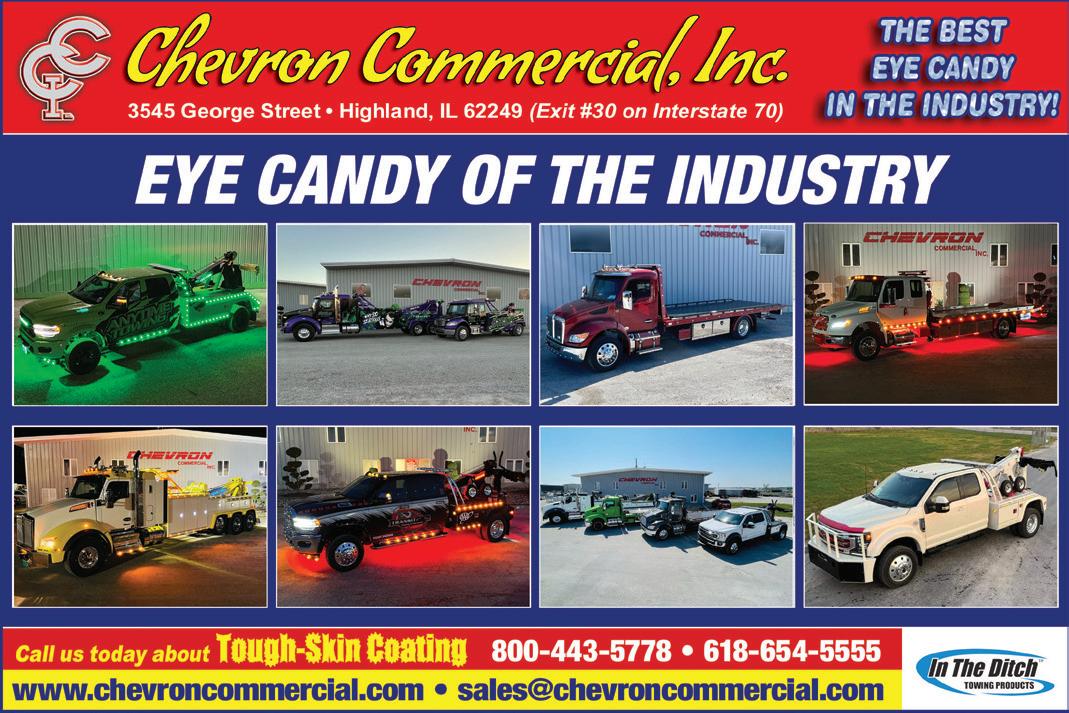
In today’s economy, there are solid reasons for regular care and maintenance of wreckers. A new, lightduty tow truck costs well-over $100K, and it should last at least five years before wear and tear indicates that it’s time for another truck.
On the other hand, sloppy trucks can give the motoring public the impression that towers are a ragtag and slovenly lot. While that’s generally not true, the industry has suffered from this image since the origin of wreckers more than 100 years ago.
So, once the snow melts, it essential to assess the condition of your wrecker to ensure it’s ready for the seasonal challenges ahead. It’s important for today’s towers to keep in mind the benefits of driving a clean, well-maintained tow truck. Modern wreckers aren’t the same old junky clunkers of yesteryear, as they’re designed for usability and longevity— provided they get proper care.

As an example of the possible negative impact of a poorly maintained tow truck, a tow operator’s tilt-cab carrier was sitting in line for its annual CHP inspection. As the cab was tilted for presentation, all sorts of fast-food containers, soda cans and candy wrappers fell out from under the truck’s seat. The CHP inspector wasn’t thrilled with all the debris, and sent the carrier to the back of the line. Upon finally arriving for inspection, the truck failed miserably.

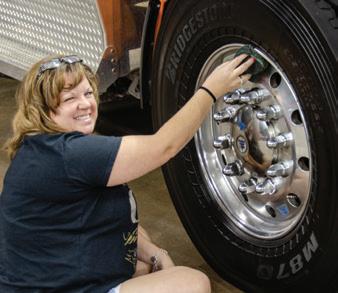
truck projects competency.
So, let’s be honest: at this very moment, would your truck pass a whiteglove inspection? If not, this narrative’s for you. Consider the following benefits of operating a pristine truck versus a junkyard dog.
Perhaps the most important consideration is “How does the condition of a beater tow truck affect the public’s view of your company?” A customer’s first and immediate impression is formed when the tow company arrives on scene. There’s a common perception that if a tow truck, and even the operator, are unkempt, customers may believe their vehicles won’t be treated with care.
Operations Editor Randall C. Resch is a retired California police officer and veteran tow business owner, manager, consultant and trainer. He writes for TowIndustryWeek. com and American Towman, is a member of the International Towing & Recovery Hall of Fame and recipient of the Dave Jones Leadership Award. Email Randy at rreschran@gmail.com. ◀
Although a messy wrecker or carrier might handle a crash scene or transport a vehicle as well as a Mr. Clean’s machine, the visual impact of a well-appointed
A cluttered, dusty, and smelly interior hardly says, “Welcome.” Customer dissatisfaction extends especially to towers who smoke. If the operator’s mentality is, “The world is my ashtray,” and the cabin reeks of cigarette smoke (or there’s a half-full bottle of tobacco spit on the seat), customers will be repelled. A truck’s seat full of grease stains only
Winter takes a toll on vehicles with its temperature swings, harsh road chemicals, and rough road conditions. While the arrival of warmer weather across North America can be a cause for celebration, it’s also the time to consider preventive maintenance to keep trucks out of the shop and rolling safely. These tech tips from Bendix provide some springtime practices to help put winter in the rear view on big wreckers (typically five tons or larger) equipped with air brakes.
When a tow truck travels through freeze-and-thaw cycles, it can damage its air-brake system. Coming out of winter, drivers and technicians should pay extra attention to component performance. For instance, air dryers mounted on the frame rail are susceptible to corrosion because of their exposure to the road. This scenario is particularly true of the seats around the purge and pressure protection valves, as well as the governor connection. Water can mix with dirt, sand, and road chemicals and form residue that can clog purge and pressure protection valves and other air dryer parts, and prevent their proper operation. In addition, steel air tanks can also corrode and develop small punctures. During inspections, keep an eye out for cracking or breakage of plastic airline tubing that connects the dryer to the truck’s air system. Chemicals and temperature cycling can also affect push-toconnect air fittings.
Air leaks may be present even if they’re not seen or heard. A good indication that your system may be losing air is if charging the tanks takes significantly longer—three or four minutes, for example, as opposed to one or two.
The same is true if the system is charging more often. Increased charging cycles means more air going through the dryer, which affects the life of the dryer cartridge.”
Bendix recommends the air dryer cartridge be serviced yearly. If the air dryer cartridge wasn’t switched out in the Fall, then Spring is a good time to replace it. Remember to replace oil-coalescing cartridges like-for-like.
When it comes to brakes, after winter, look for corrosion, damage, and missing
or loose components. Examine brake friction for good condition—no lining cracks, missing portions, or oil or grease contamination—along with a minimum thickness. If it’s time for new friction pads, be sure to stay up to OEM specs. If the friction pads need to be replaced, do so on both sides of the axle.
In addition, for brake chambers, make sure the dust plugs are seated properly to prevent corrosive materials from getting inside and causing internal damage. Technicians should also measure chamber stroke at each wheel-end to ensure proper brake adjustment. In addition, examine the air lines. Make sure that everything is tied up properly and that there is no chafing. Check for damage in the mounting mechanism as well.
On vehicles with air disc brakes, examine the rotor for corrosion and ensure the cooling fins are not plugged up, which would prevent the rotor from cooling properly. Inspect the chamber for damage or corrosion. Also, look at the air hoses and clamping mechanism to ensure they’re intact.
Inspect the boots for punctures or tears too, as any opening into the caliper can lead to corrosion. And, check the integrity of the guide pins. Replace parts where necessary, and make sure the shear adapter cover is in place and fully seated. The pads should move freely in the carrier, so you should remove them and clean the carrier surface with a wire brush, if necessary. Also check to ensure that the brake moves freely on its guidance system.
For brakes overall, the importance of lubrication can’t be overstated: It keeps moisture from building up and enabling corrosion. Coming out of winter, newly grease all your automatic slack adjusters, clevis pin connections, cam tubes, shafts, and bushings.
The feel of the brakes is also important, especially if they’re responding more slowly to the driver’s push of the brake pedal. This sensation may indicate valve seals in the system have had their lubricant degraded through corrosion. Or possibly by the use of de-icing solutions if the air system froze during the winter.
If you’ve had to use a de-icing solution (though generally not recommended by Bendix, unless needed to keep your truck on the road), then Spring is a good time to check for leaks around brake valves where O-rings might have been exposed to the chemicals. Replace valves that may be sticking internally because of loss of
lubrication. Some fleets routinely change out air valves as part of post-winter preventive maintenance.
Technologies such as antilock braking systems (ABS) and electronic stability control (ESC)—which are the foundation of advanced driver assistance systems (ADAS)—are not immune to rough winter conditions.
One ABS concern centers on wheelspeed sensors, which can be susceptible to chassis harness issues. Wire harnesses can get damaged by chafing, gravel, or corrosion. Any wiring on the chassis can be at risk because once a damaged wiring harness gets wet, it is more likely to short-out. A common source of calls to the Bendix tech support team this time of year is post-winter electrical shorts and the brake system component malfunctions that result.
Frayed or cut chassis wires can also cause potential issues with the ADAS camera or radar. Bendix advises checking the chassis harness and connectors near the ADAS camera or radar should a problem with the system be detected, or if the system doesn’t seem to be working optimally.
Also, an issue that may arise for stability control is when the steering angle sensor goes out of calibration, which can sometimes happen after a front-end alignment. It’s important to calibrate the steering angle sensor after almost any work is done on the front-end.
Radar units face their own challenges. Since the radar is on the front of the vehicle, the connector can be exposed to all sorts of chemicals. This is especially true in winter when salt and other substances are used on roads. It’s a good practice to make sure the connector is properly covered, sealed, and secured, which will help minimize the corrosion that may occur from repeated exposure to moisture and road chemicals.
Tires help ensure that ADAS technologies work at their best. Drivers can double-check their wheel-ends for adequate tire tread depth and unusual wear like cracking. In the shop, technicians should make sure tire pressure monitoring systems are operating properly after the temperature swings of winter, since running on the right inflation is critical.
This Spring, hit the road with enhanced safety, uptime, and peace of mind by addressing winter’s toll on your trucks.
Information from the Bendix Tech Tips series can be found in the Bendix multimedia center at bendix.com

adds to this bad image.
In clear contrast, a sweetsmelling, vacuumed interior helps to diffuse a customer’s stress, putting them at ease so their unwelcome tow experience is more tolerable. It takes only a short time to rid interiors of trash, un-stowed equipment, and accumulated dirt. Don’t forget to wipe-down door handle areas and dashboards with a lightly scented vinyl dressing.
Thoughtful towers have a professional mindset that, “My truck is my office,” and strive to keep it orderly, while some operators never learn the importance of keeping a truck clean through their shift.
Truck interiors are bound to get dusty and trashed-out as the day progresses. At the end of the day, a quick sprucing up is in order to make ready for the next day, or the incoming shift driver. A clean tow truck is a happy truck, right?
If a tow truck has an elaborate paint scheme, mural, or wrap, frequent washes and waxing helps prevent premature oxidation. Shiny paint and gleaming chrome are essential aspects of a tow truck’s positive presentation and branding.
In addition, an extra benefit of
power washing the underbody, wheel-lift and bed rails helps to expose leaks in hydraulic and air hoses, and cracks in the frame and mounting welds, which might otherwise be concealed by winter’s road grime. Dedicated tow company owners will even go to the expense of hiring professional detailers to clean trucks in the fleet, especially prior to DOT inspections. In fact, a law-enforcement inspection might require power-washing and removal of wheel covers as part of the procedure.
Both new and old tow trucks are required to pass DOT and/or CVSA inspections, regardless of the niche the tow company serves. When a tow truck’s driver slowly inches through a commercial truck scale, a funky-looking wrecker may attract a hawk-eyed inspector looking for violations. When the green light at the scale’s drive-thru turns red, a citation is likely awaiting inside the scale house. In contrast, there’s a reasonable expectation that well-maintained

and well-equipped trucks will quickly pass an unannounced, impromptu inspection.
As commonly mentioned in lawenforcement contracts, tow trucks serving the police community are required to be specifically equipped and well-maintained. Keep in mind that the beat cop or highway patrol officer who’s hell-bent on enforcing tow truck violations usually can’t find fault with a truck when its equipment is well-maintained and in tip-top shape.
Moreover, just as “clothes make the man,” (or woman), a neat, clean and tidy wrecker makes
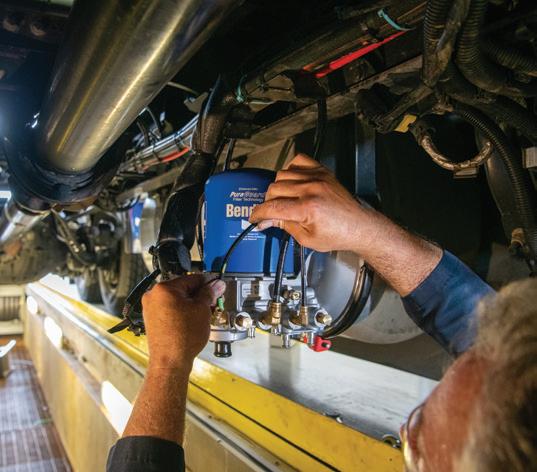
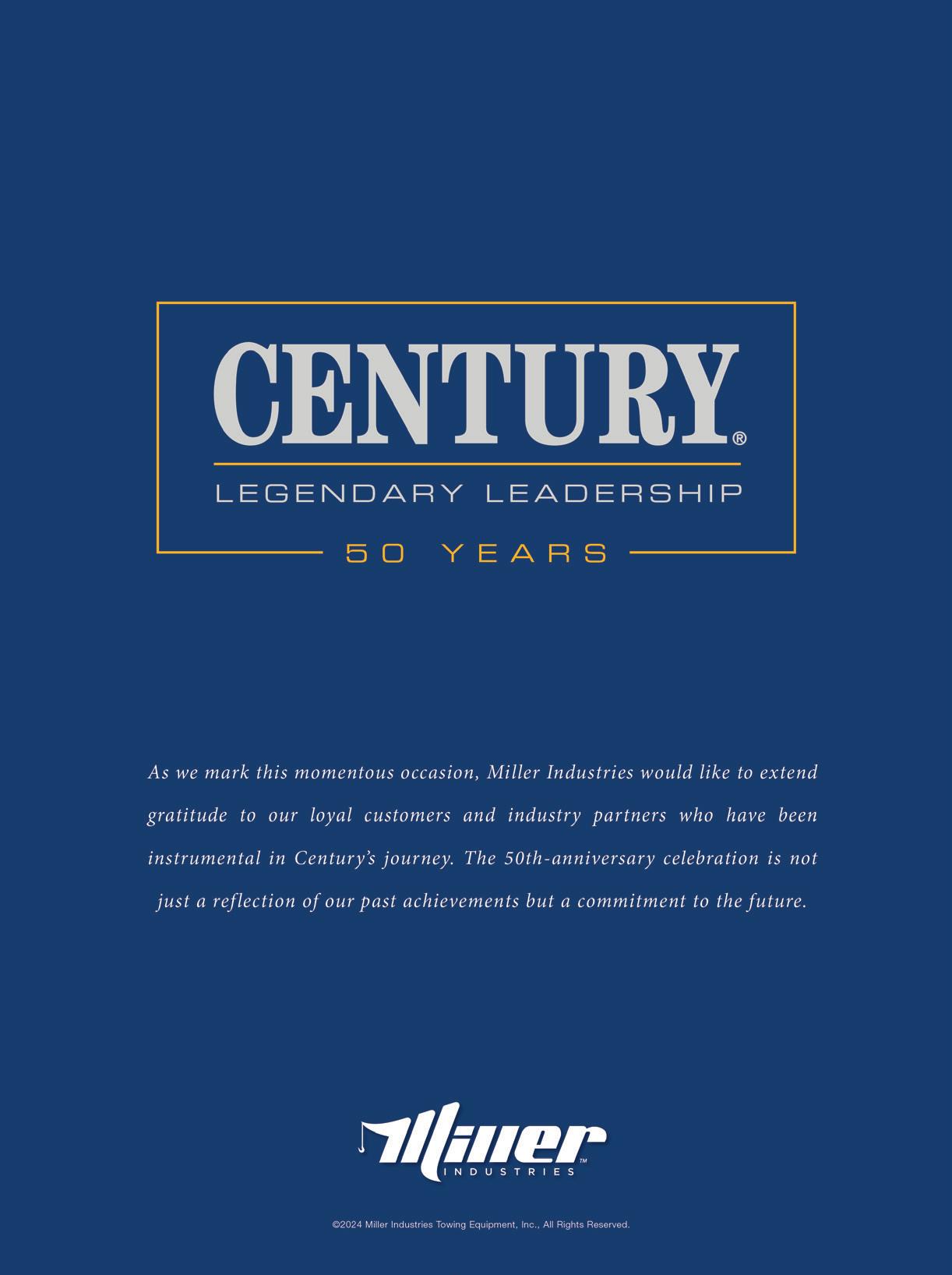
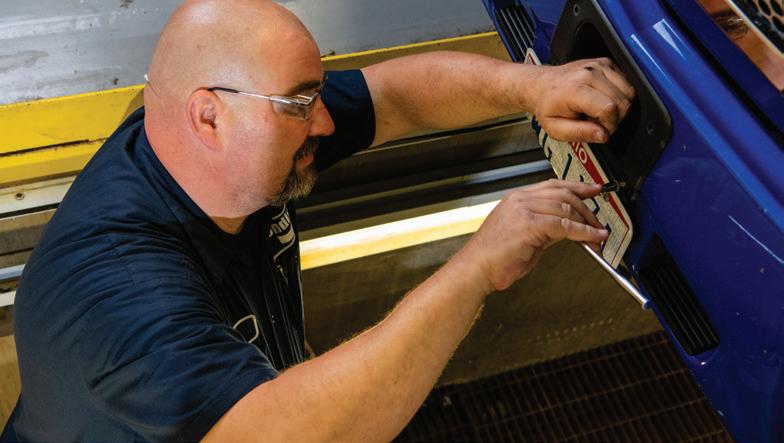
operators feel more confident and self-assured about their abilities. And they’re likely to operate in a safer and more conscientious manner.
That goes for older trucks as well. They can be well-maintained and well-equipped, and look nearly “good as new” with proper care and treatment. With years of
use, hard-working tow trucks are bound to suffer dents, dings, or cracked windshields in the course of operations. Unsightly damages create an undesirable junkyard appearance. While taking a truck out of service for much needed repairs can be a difficult process, it’s wise to make corrective repairs in a timely manner.
When you’re looking to buy a used truck for your operation, would you buy one that’s filthy, missing parts, and barely runs? Or a truck that’s tidy and in good running condition? The answer is simply common sense. Some tow trucks are overly used and abused, and aren’t a smart choice.
When tow owners invest hardearned monies into new or used trucks for their fleet, they serve as a rolling billboard. For towers shopping for a used truck, a nicely preserved one generally brings more dollars at the time of sale.
In addition to post-winter care, the process of tow truck inspection is actually a daily requirement. Think of it as a pilot’s “pre-flight

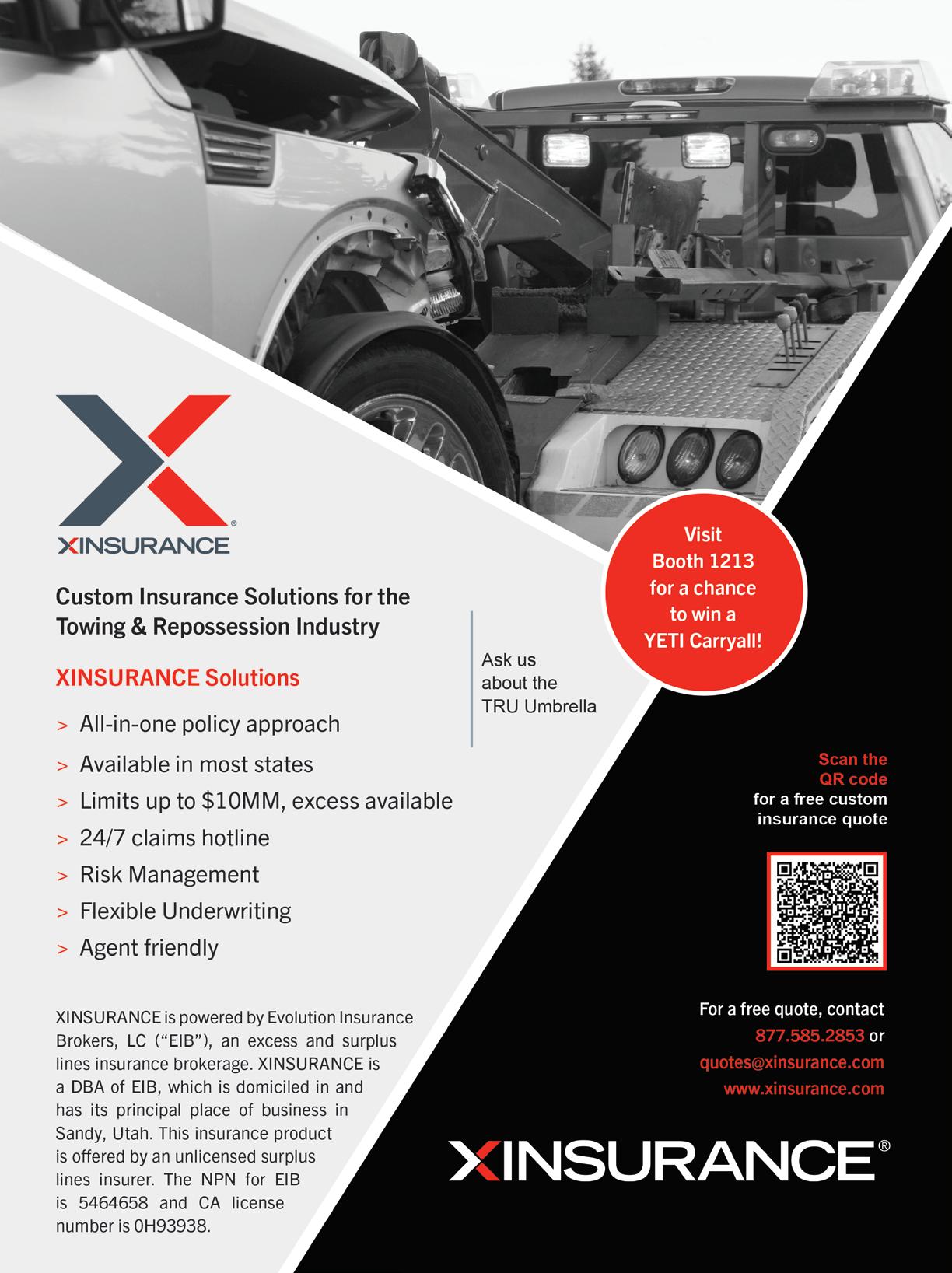

checklist.” Likewise, tow operators must make diligent efforts to conduct regular and complete safety inspections prior to leaving the facility. If an item is damaged or needs replacing, an appropriate notation must be made on the company’s inspection form, and promptly addressed.
When the inspection form is
completed, it’s signed, dated, and turned into management. The operator’s signature indicates that the tow truck and its equipment was inspected, is safe, and ultimately roadworthy. Any falsification that intentionally ignores a “known issue” could result in criminal prosecution or civil liability should a preventable accident, injury,
death, or extensive property damage occur.
Simply put, owners should insist on thorough and accurate inspections and allow operators a reasonable amount of time to complete the inspection. Towers must make an honest recording of the truck’s condition prior to going into the field on a call. When the inspection is completed and subsequently turned-in, the operator’s liability shifts to the company. It becomes the company’s responsibility to either immediately pull the truck from service or determine a reasonable time to schedule repairs.
Note: Some states require that a copy of the most recent tow truck inspection form is kept in the tow truck’s glovebox, and available upon request by law enforcement, DOT, or the highway patrol.

When working trucks get dirty after spending hours and days sloshing through snow, rain, mud, and the overall yuck of winter, a thorough cleanup is in order. It is especially important to remove corrosive road-salt brine sprayed by snowplows during the winter season.
There are long term benefits to keeping a wellmaintained, nicely cared-for tow truck, carrier, or service vehicle. Set the tone for the condition of your trucks. If you don’t care, it will be evident in the appearance, and ultimately affect the durability of your wreckers. Implement a policy/procedure manual detailing each of the following points:
• Management oversees the condition of each truck.
• Operators are required to maintain assigned trucks and service vehicles in acceptable condition.
• Operators are required to maintain equipment and accessory items on the truck.
• Operators are required to wash and care for their assigned trucks.
Remember, there’s just one chance to make that first, best impression.



Since winches are exposed to harsh weather, and handle heavy loads, inspect them regularly for grit and wear, and check the gear oil level as well. This BRADEN 20,000-lb worm gear recovery winch is mounted on a Trail-Eze TE801 trailer utilized as part of a wrecker fleet.

The towing industry depends on reliable access to parts and service for winches and related key components that are exposed to the raw elements and hard use. Since car carriers, tow trucks, and recovery trailers handle everything from disabled vehicles to oversized loads, maintenance and service schedules are an integral part of the overall operational plan.
Towing and trailer operators should expect a well-maintained winch to operate at peak efficiency in line with its engineered capabilities. This requires regular preventative inspections, as well as a trusted service partnership.

Leading distributors who service the towing and trailer industry are often
WARN’s Series G2 Hydraulic Winches feature an all-new structural design that makes the clutch-mount far more durable. Other features include easier remote clutch operation from both driver and passenger side of the vehicle; a more robust and serviceable winch design; and a stronger gear train for increased performance. The ball-bearing design and aircraft-grade lubricants enable the drum to turn easily, even in extremely low temperatures. Also, the 4-position clock-able hydraulic motor allows for easier access and simpler serviceability.

When rebuilding a winch, a BRADEN factory-trained technician at Winches Inc.'s location in Broken Arrow, Oklahoma always does a free function test to ensure that it meets factory specifications. Winches Inc. is an inaugural BRADEN Designated Service Partner (DSP) under a new program being launched by PACCAR Winch which functions as an extension of the service department.
recognized for robust product and parts inventory, as well as full-service maintenance and repair capabilities. They recognize that downtime equals lost revenue, and strive to work as a partner with towers to make sure critical components are always in the best working order.

Neglecting maintenance can result in performance gaps and lessen the total usable lifespan of winches, wire rope and hydraulic systems. Dirt, grit, and grime can build up and take their toll. Improper use or general lack of attention can put the safety and effectiveness of an entire towing or recovery operation at high risk.
Regular inspections are essential to identifying potential equipment hazards that could lead to accidents, injuries, or unwarranted downtime. Walk-around routines are essential for addressing signs of wear or damage which can potentially threaten safety and performance outcomes.
At the most basic level, check the gear oil level and the wire rope weekly. Depending on usage, gear oil needs changing at least annually to remove wear particles that can erode bearings, gears, and seals. Mounting hardware should be re-torqued at the same interval, and hydraulic system filters changed according to the manufacturer’s recommendations.
Daily operational checks can be as simple as testing winch equipment under appropriate light-load conditions, ensuring smooth operation while paying attention to any unusual activity or noises that could indicate a problem or internal damage. In addition, early identification of cracks in hooks, frayed or ◀



Ramsey’s Omega model is a low-cost, hydraulic planetary winch built to perform under extreme conditions. It features rated line pulls ranging from 8,000 to 12,000 lbs., and has a low-profile envelope that allows for a compact installation, along with saving weight and space. A spring-loaded, pull-and-rotate clutch is designed for free spooling, while the automatic load-holding brake offers strength and reliability. A roller-tensioner comes standard with each unit, so it is ready to install as soon as it’s received by a tower.
worn-out wire ropes, or other signs of deterioration in rigging components creates a safer working environment by significantly reducing the likelihood of catastrophic failures.
Tow operators require robust integrated winching capabilities from units that are both high performing and reliable. This includes worm gear and planetary winches with versatile mounting options engineered to
deliver optimized pulling power and line speed based on system requirements.
Proactively ensuring components such as winches are properly matched with the equipment’s hydraulics increases the probability of improving efficiency during high duty-cycle operations inherent to towing and advanced recovery situations. Working closely with a factory trained distributor helps facilitate this process.
Keeping winches in good working order means taking a nononsense approach to following the manufacturer’s maintenance schedules and employing professional services when needed and as required. Periodic inspection for wear or damage is essential. Grinding noises or other obvious signs may indicate it’s time for an overhaul.
If problems persist or complex
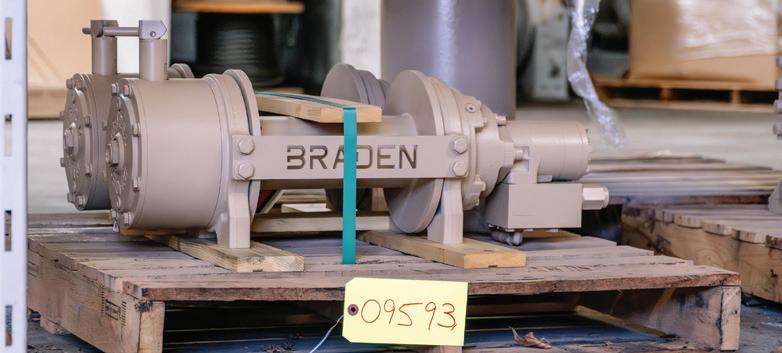
Braden’s TR Series is designed for stand-alone use on trailers as well as for towing and selfrecovery operations. With a compact, low-profile design, these hydraulic planetary winches are currently available with line-pull ratings from 12,000 to 30,000 lbs. TR Series units feature either manual or air-actuated freespool clutch, low-friction ball bearing drums, and oil bath lubrication for serviceability and long life.
For heavy-duty recoveries, dp Winch manufactures a complete line of planetary winches, capstans and bumper packages for major OEMs and the defense industry. The company’s military-grade equipment is put to work on utility trucks, towing and recovery vehicles, trailers and numerous government vehicles used in defense operations around the world.

repairs are needed, consulting with a factory-trained service technician or the manufacturer's support team is recommended to ensure proper diagnosis and repair, maintaining the safety and reliability of winch equipment.
Some tow companies prefer to swap out their winches periodically, following a rotating service schedule that allows for greater predictability and increased productivity for tow operators requiring near-zero failure rates and the maximum allowable uptime. The process is fairly simple, as outlined by Joe Hillenburg, National Sales and Marketing Manager at Winches Inc.
“They ship us the winch,” he stated. “We put it in our shop. We tear it down, look, and see what is inside the winch. We call them back, ‘This is what I’m seeing…’”

For a quick turnaround, Winches, Inc. keeps the most in-demand parts in stock and on shelves. And when rebuilding, the technicians there always do a free function test, and bring the winch back to factory conditions and specifications.
Keeping winches in good working order typically involves timely inspections, informed troubleshooting, and regular touch points with professional service technicians. When equipment problems do arise, maintaining strong relationships with trusted sales and service providers can mean the difference between sitting idle, or getting back on the road quickly.
Beyond preventive service, the need for professional maintenance or repair is inevitable in many situations to keep a tow operator’s winches—and business— running smoothly.
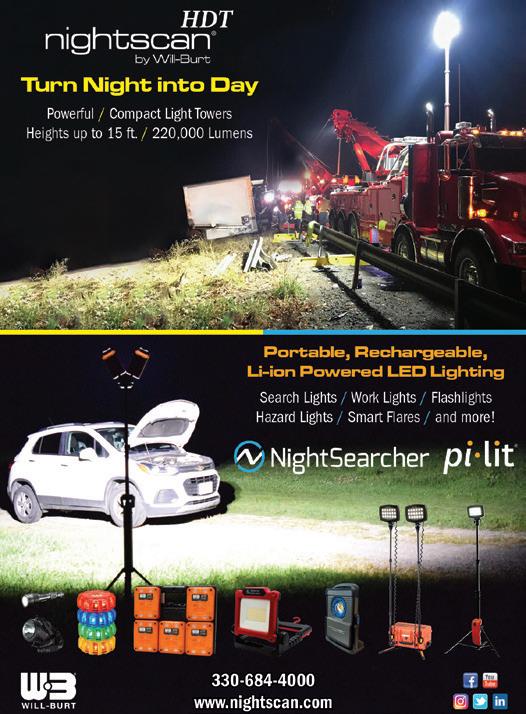


Many towers probably recognize the REO truck brand, possibly because of the rock group REO Speedwagon that borrowed the name. But what about the REO initials? Those stand for Ransom E. Olds, an entrepreneur who founded multiple companies in the automobile industry, including Oldsmobile in 1897. In 1905, Olds left Oldsmobile and established a new company, REO Motor Car Company, in Lansing, Michigan.
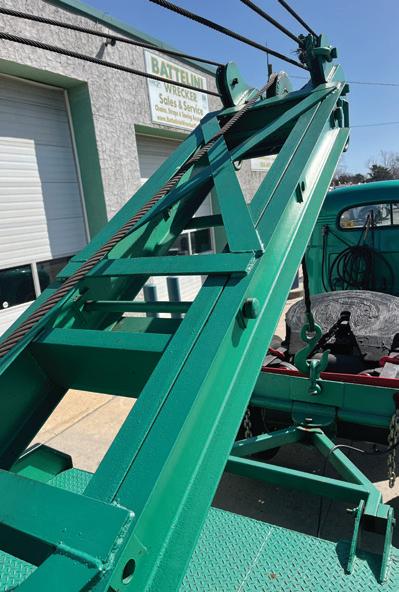


The REO Speedwagon was “not your father’s Oldsmobile” as the ad slogan once proclaimed, but a revolutionary truck introduced in 1915, and was a precursor to today’s pickup trucks. It was known for higher horsepower and better performance back in the day, and led to a series of popular models over the years.
The 1956 REO model A-603 shown here is owned by Albert Battelini of Battelini Wrecker Sales & Service in Vineland, NJ. The truck originally had a 220 horsepower Gold Comet gas engine.
“My father Dominick bought it from an REO dealer in Philadelphia in 1960,” Albert recalls. “He stretched the frame and designed and built the wrecker unit and body in our shop.” (Dominick passed away on December 7, 2020 at the age of 92 years old.)
The wrecker body has a 30,000-pound Garwood winch with 150 feet of 7/8” cable. The boom is extendable, with an electric motor for raising and lowering it.
In 1965, Dominick removed the Gold Comet gas engine and replaced it with a Detroit Diesel 6V71 rated at 238 horses. The truck was in service from 1960




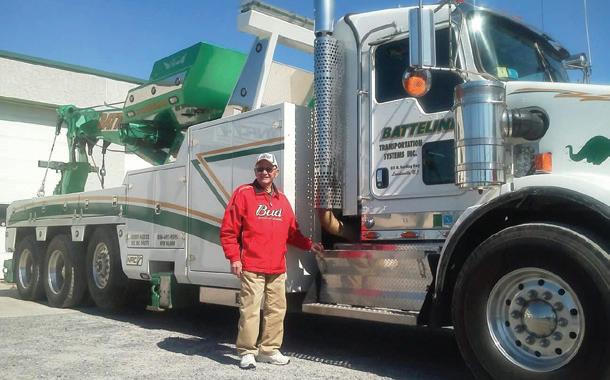
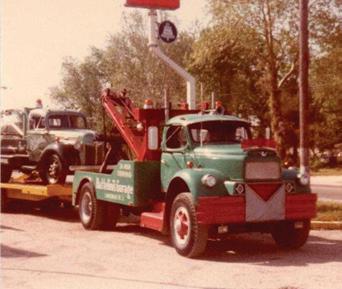
till 1986. Once the wrecker retired, Albert restored it and now just uses it for shows, parades, and other events.
“Parts for this truck are very hard to find these days,” he admitted. “REO trucks are so rare.”
As time went on the front axle and steering box wore out and Albert didn’t drive it much as he felt it was unsafe. It took five years of searching for replacement parts, and he finally found a front axle and steering box in
upstate New York.
“With the help of some friends we replaced the front axle and steering box, and made the truck as good as new,” he related. “Now we drive it as much as we can. We drove 100 miles to last year’s American Towman Expo in Baltimore.”
There it took home a trophy in the Vintage Class, and was a fan favorite at the show.
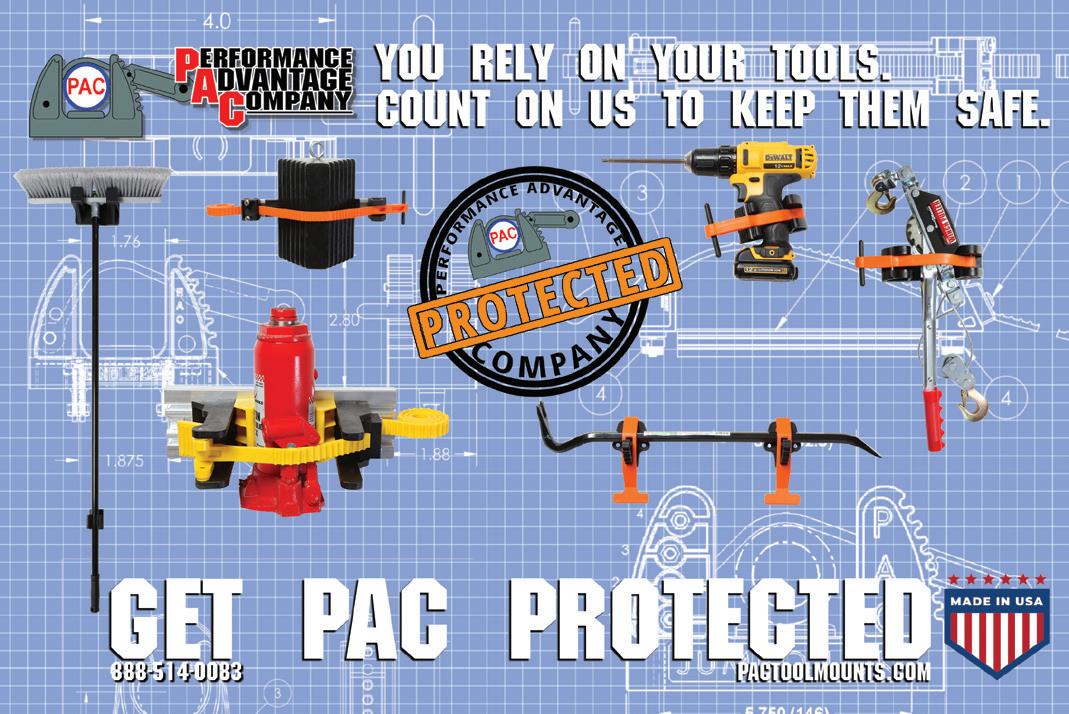
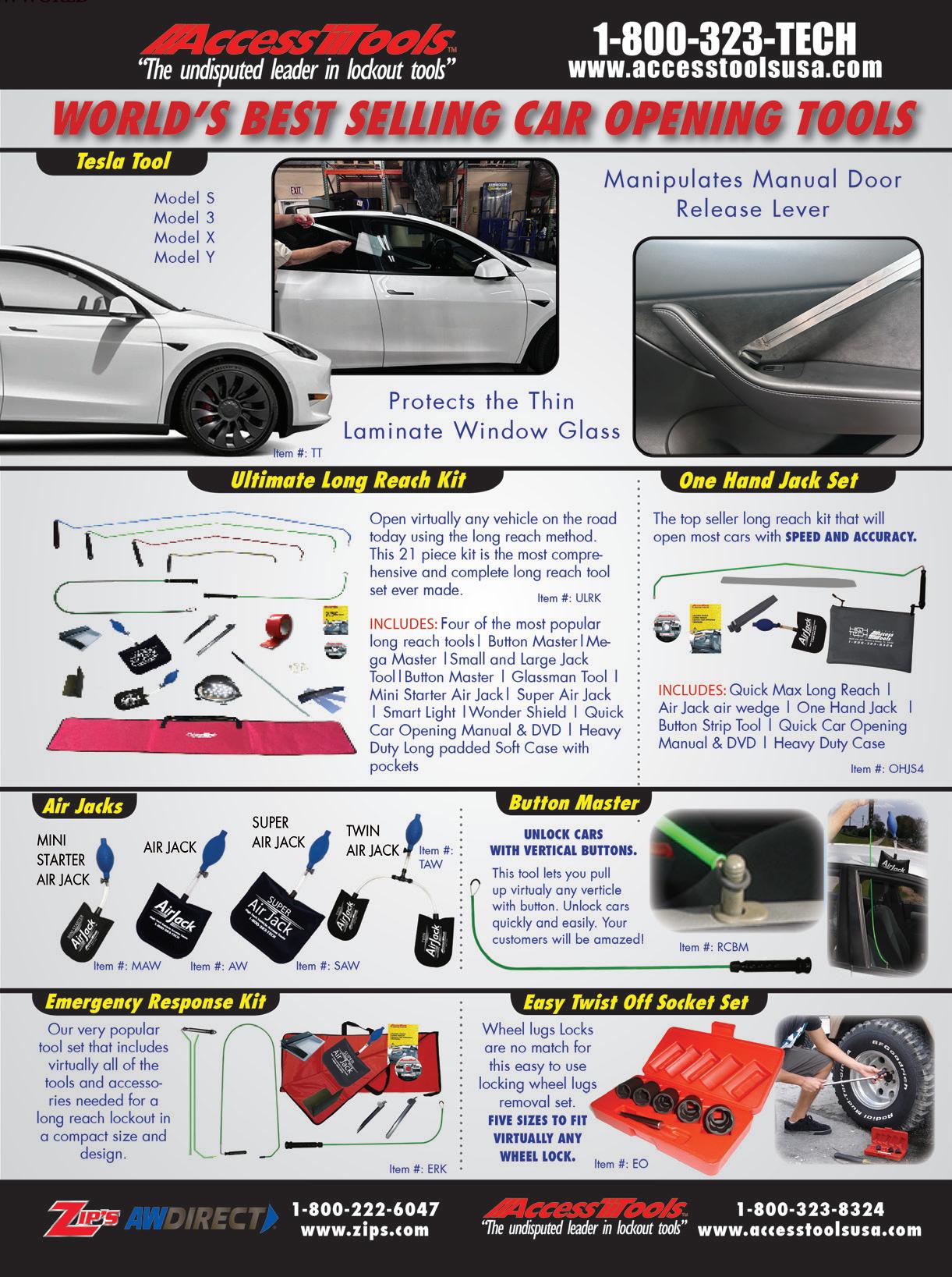

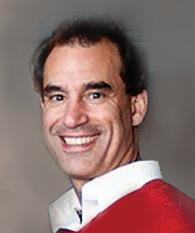
In January of 2021, Gary Hoffman, owner of Tow King in Waco, Texas, and president of Southwest Tow Operators Association, had the opportunity to acquire a longrunning body shop with a small wrecker service in West Texas.
“It was in business for 25 years before we took it over,” said Hoffman. “It was originally Polansky’s Wrecker Service and Auto Czeck Collision & Repair. We kept the shop name and changed the wrecker to our own name—Classic Towing & Recovery.”
For Hoffman and his partner Randy Solberg, the business opportunity represented a chance to diversify, widen the towing business to another county, and potentially capitalize on the vehicles that they were already towing and in need of bodywork.
From the outset, Hoffman maintained that the goal was to increase the company’s
size, which they have successfully accomplished, growing yearly, both in volume and revenue, while increasing the number of employees.
One key to their success Hoffman attributes to Solberg, who runs the dayto-day operations, and their body shop manager, Shawn Kaluza, who has helped them find ways to grow the business, along with Hoffman providing guidance and moral support as well.
“Both of them have been instrumental in the push and the growth that we’ve had,” Hoffman noted.
Strategically, the acquisition made sense, allowing them to expand their towing operation into another county along a busy interstate, where it was already established on a police rotation.
However, like most businesses, this one has had its share of “bumps in the road,” Hoffman admitted. On the towing side, there was a bit of backlash from some of the competitors in the area.
“Some were not receptive,” he said. “and some were. But it’s smoothed itself out since then.”
In terms of the body shop, Hoffman feels they’ve had to overcome some setbacks. Early on, a key employment issue involved losing an experienced painter. In addition, when Covid hit, the company experienced supply-chain problems. Immediately following, they struggled with production backlog issues post-Covid.
Nevertheless, once they found another experienced painter who was able to speed up the workflow, and also brought in a new paint supplier, the business situation markedly improved.
“Our supply costs went down, saving us money and cutting our expenses in half,” Hoffman explained. “While our jobs went up.”
Through it all, Hoffman expressed satisfaction with the acquisition.
“I’m happy with it. It’s doing good. I’m glad we did it.”
Not resting on their laurels, the company looks forward to participating at TowXpo Dallas/Fort Worth on June 20-22, to attend DRIVE seminars, where they will get some pointed instruction on improving their body shop, expanding their business, and staying on the path to continued growth.



Gass Automotive
Santa Fe, Texas


Matthew C. Fueston is a B2B writer and editor, covering “big iron” equipment, and the men and women who rely on it, for nearly 15 years now. From towing and recovery to construction, mining, and oil and water drilling rigs, he always puts the story of the real people in the field first and foremost. He may be reached at matt@fuestonassoc.com.
One of the first things Tommy Gass admits about being an accomplished tower is that it takes some grit and determination.
“It’s not for the faint of heart,” he admits. “To make it work, you have to be all in.”
He feels that people in various businesses try to make more money by either spending less or working less. But that’s not the way it works for him. To drive home the point, he shares straightforward methods for his Houston-based business, Gass Automotive.
“We reinvest 80% of our earnings back into the company every year. We’ve done that almost since the beginning. And I still go out on calls.”
Tommy mentions another key aspect to success: Any family that is involved in the towing and recovery business is much more likely to make it work if the family is united in their commitment to that success, even if not every member is actively involved in the business. In Tommy’s case, he gives credit to his spouse for her support and sacrifice through the years.
“Without my wife, Cacey, none of

this would have been possible,” he shares.
Even with this level of commitment, the story of Gass Automotive did not follow a smooth trail. There were obstacles early on, and some barriers had to be knocked down or circumvented. Tommy, however, is not the type of person who gives up.
In 1990, he started working as a service tech at a Chevrolet dealership in the Houston area, as well as operating a tow truck part-time. A year later, he bought his own tow truck, and built a side business until he sold his towing company in 1994.
Tommy continued to work in the Chevrolet service department as a shop foreman until 2001, ◀
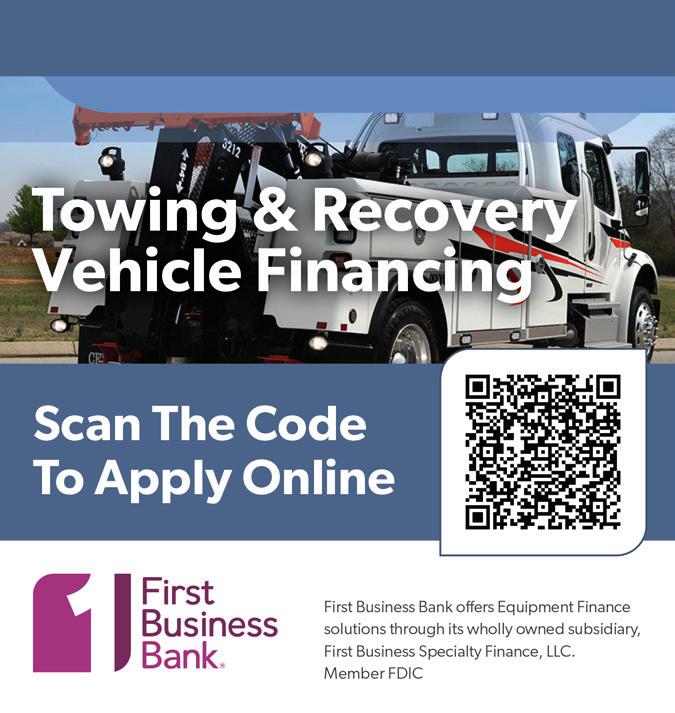

when he opened the doors to Gass Automotive, Inc., which quickly became a busy, four-bay service shop.
In 2002, Tommy got back into the towing and recovery business, initially as a sideline for his service shop. Over the next few years towing proved successful and in 2005, it provided Tommy with enough revenue to buy his first heavy-duty tow truck.
A setback involving a personal matter hit Tommy in 2008, causing him to lose his towing business, but he kept on prospering with Gass Automotive. Later, in 2013, Tommy was able to jump back into towing and recovery in a big way. He started towing all sizes of vehicles and bought another heavy and two rollbacks. The business branched out into tougher and more complicated recoveries, adding its first rotator in 2017, and two more the following year.
Since then, he has added around 20 trucks to the wrecker fleet, including Jerr-Dan rollbacks, carriers, rotators, and heavy and medium-duty tow trucks. In all, with his service and towing businesses combined, the fleet numbers about 90 pieces of equipment. These include some nonvehicular equipment, such as light towers, gen-sets, and skid steers, along with a bulldozer, boom lift, and mini-excavator. The main tow fleet, however, consists of service and tow trucks of one sort or another.
In fact, in view of his passion for the towing industry, the most surprising fact is that the towing part of Gass Automotive is second in size to the maintenance, repair, and service part of the company.
“Right now, we have an 18,900 square-foot, full-service repair
facility,” he says. “That is only about 1,000 square feet less than just the lot our original shop sat on! But we need the room.”
That’s because Gass Automotive is not only a full-service dealer for both Cummins and Isuzu Industrial Diesel, but also handles Landoll trailers and Tiffin and Spartan RV chassis. In addition, Gass has service and repair agreements with the Mack and Volvo dealerships in the area.
Sitting on a 10-acre lot provides Gass Automotive with plenty of space to expand, which is important because the company has been consistently growing at an annual rate of 30% since at least 2014.
This success has allowed the business to do some things that it probably couldn’t have done otherwise.
“A good example is League City Hydraulic Hose & Fittings, a totally separate company we’ve run for over 16 years,” he points out. League City Hydraulic Hose & Fittings fabricates custom or standard hose assemblies, and provides repairs or replacements as needed.
Getting back to his towing operations, Tommy is especially appreciative of his three Jerr-Dan JD50/60 (HDR1000) rotators. He points out that they get a great workout because he can do things with them that might otherwise be impossible.
“For instance, we do a lot of straight lifts, lifts that in the past would have required a big 150-ton mobile crane,” he explains. “But now, we just look at it as standard rotator work. We're doing the work with a truck that's more versatile and can get in and out of traffic far better than a rubber-tire crane. If you’ve ever driven in Houston traffic, you know how important that is.”
Going into further detail, Tommy points out that, “These rotators are designed to do recovery work, of course. They can do a direct, vertical lift, or they can be set up to pull the casualty to you or maneuver it in other ways. You set up all the rigging at just the right angles to pull most efficiently and safely.”
He adds that sometimes Gass has used all three at the same time on big, complicated jobs more than once. But, it is a lot easier to get the JD50/60 set up at an incident scene. He can save about a half-hour on setup in comparison with a different make of rotator he once ran.
“You know how important every minute is on a busy interstate,” he emphasizes. “Those machines are great, and the factory support has been incredible.”
He says that customers like the fact that his towing operation does a turnkey job. It can do that because it has all the auxiliary equipment that could possibly be needed. And obviously, very well-trained crews to do any and every job.
“But I'm still hands-on every day,” Tommy notes with pride. I take all the big recoveries myself.”
Looking at Tommy Gass’s businesses today, his story shows the hiccups and obstacles that he overcame with patience and gritty persistence. He is the first to admit that what has worked for him, won’t work for everyone.
But Tommy’s story, like so many among the towing fraternity, shows that there are many paths that lead to success. Persistence, flexibility, alertness to opportunity, dedication, hard work, and attention to detail are all qualities common to those who find success. Or perhaps “find” success is not an accurate description of the process. It’s more accurate to say, “Those who grab success by the throat—and just don’t let go.”





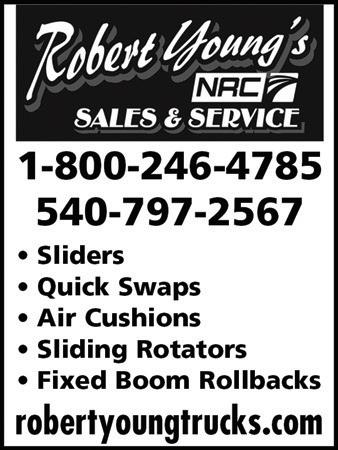

Financial Trade Publication Touts
Miller Stock Investorplace.com, citing the positive performance of Miller Industries’ stock over the last year, encouraged investors to check it out. They noted that Miller Industries’ stock has steadily outperformed the S&P 500 in 2024. The stock, symbol MLR, is up 21%, nearly double the 11% gain in the S&P 500 index. Over the past 12 months, Miller’s stock has risen 42%. At the same time, the company’s market capitalization is less than $600 million, classifying it as a small-cap stock. It trades at nine times forward earnings and it pays a quarterly dividend that yields 1.52%.
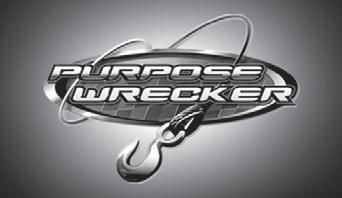





Source: investorplace.com
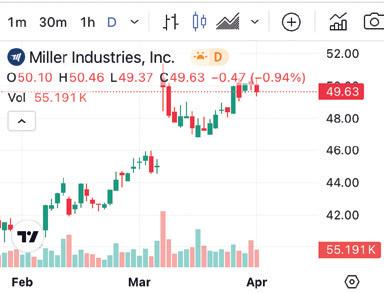
Certain models of the 2023 and 2024 Ford F-650 and F-750 are being recalled due to an issue with the parking brake. The hazard posed occurs when the parking brake releases unexpectedly, which might result in a vehicle rollaway, increasing the risk of a crash or injury. The brake may malfunction and allow the lever to be released without pressing the release button.
Ford is not aware of any crashes or injuries related to this condition, but affected vehicles are select F-650 and F-750 models built be-
tween July 13th, 2022, and December 8th, 2023. The number of vehicles affected is 18,244, and a remedy is currently in development.
Communications from Ford to vehicle owners are expected to begin on April 8th, 2024, and the Ford reference number for this recall is 24S09. Contacts:
• Ford Customer Service: 1-866-436-7332
• FoMoCo Recall Number: 24S09
• NHTSA Toll Free: 1-888-327-4236
• NHTSA (TTY): 1-800-424-9153
• NHTSA Website: www.nhsta.gov
Source: ford.com
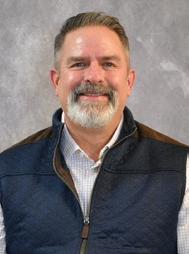
Ramsey Industries has announced the promotion of Rick Brewster to the position of Vice President of Sales and Marketing. In his new role, Brewster will lead all aspects of Ramsey Industries’ commercial initiatives, including revenue generation and growth, customer service, and marketing. He will report to Kerry Baskins, president and CEO, and serve as a member of the Ramsey Executive Committee.
Brewster started his commercial career in 1998 with TV Guide, successfully progressing through roles of increasing responsibility. He joined Ramsey Industries in 2013 and has held positions in sales and operations planning, CRM administration, and customer service management. He has been instrumental in the design and support of many of the company’s commercial processes.
Ramsey Industries is a leading manufacturer of industrial and commercial
winches, service cranes and service truck bodies, and planetary gear drives through its three brands: Ramsey Winch, Auto Crane, and Eskridge Inc.
Source: ramseyindustries.com
Cummins recently shared its plans for the company’s updated X15 engine platform, including how the HELM fuel-agnostic architecture got its name. HELM stands for High Efficiency, Lower emissions, Multiple fuels. The various fueling offerings are derived from a common-base engine, which means they have some common parts. Below the head gasket, the engine variants will largely have similar components, but above the head gasket, components will vary based on fuel type. The X15 architecture utilizes a belt-driven, high-output 48-volt alternator and after-treatment heater.
“We ultimately believe that there will be a place for more efficient diesel, natural gas and hydrogen internal combustion engines for many years in the commercial vehicle markets we serve,” said Brett Merritt, vice president for Cummins’ on-highway engines. “Those products, together with Accelera by Cummins zero-emissions products, will help our customers of all shapes and sizes reduce emissions today and well into the future.”
The updated diesel X15 will be compliant with 2027 U.S. Environmental Protection Agency and California Air Resources Board-aligned regulations at launch. It is designed to both reduce greenhouse gas emissions and improve fuel efficiency, while retaining the power ratings of the current engine with up to 605 horsepower and 2,050 lb/ft of torque, Cummins said. It will be capable of using biodiesel blends up to 20% and renewable diesel blends up to 100%. A start date for production is not yet available, but a Cummins spokeswoman said it will be ready when the regulations take effect. All X15 engines are produced in Jamestown, N.Y.
The X15N, a natural gas variant,
will be the first of the HELM variants available to customers. That engine is set to begin limited production later in March with full production set for July. The X15N can already be ordered through Peterbilt Motors Company and Kenworth Truck Company dealers, with deliveries expected to start later this year. Serial production of Kenworth T680 and T880 models with the engine is scheduled to start in mid-2024.
Source: cummins.com
Stertil-Koni, a provider of heavy-duty vehicle lifts in North America, announced that Brett Delp has joined the company as National Account Manager. Delp brings more than 13 years of experience in the commercial vehicle industry to his new post, including firsthand shop knowledge, product development, national fleet management, and national account management.

Prior to joining Stertil-Koni, Delp most recently served as National Account Manager for Dorman Products, where he successfully grew fleet relationships and distribution networks nationally. Delp earned his associate degree in applied service management from Wyotech, with certifications in HD and LD Diesel. He continued his education at DeSales University, obtaining a bachelor’s degree in business administration.
In related news, Sarah Stoner, has joined the company as Regional Sales Manager for Canada. Stoner brings a 17-year track record in automotive tool and equipment sales across Western Canada.
Source: stertil-koni.com

This Festive NRC Rotator was an Early Xmas Present
By Steve TempleAn 85-ton wrecker obviously wouldn’t fit into a Christmas stocking hung from the mantle, nor under the tree in a gift-wrapped box. But this NRC CSR85 Heavy Incident Manager does have a festive vinyl wrap. And, it arrived at McGann & Chester Towing & Recovery in Pittsburg, PA

The detachable underlift allows the boom to slide all the way aft to the tail panel for more recovery access.
just a few days before the holiday, as promised. Just how Santa managed to get it down the chimney is a bit of a mystery, but no matter, it arrived on time.
“I had been waiting two years,” related company owner Bob McGann. “At the time, a cab and chassis were hard to get. I bought myself a present.”
When the wrecker showed

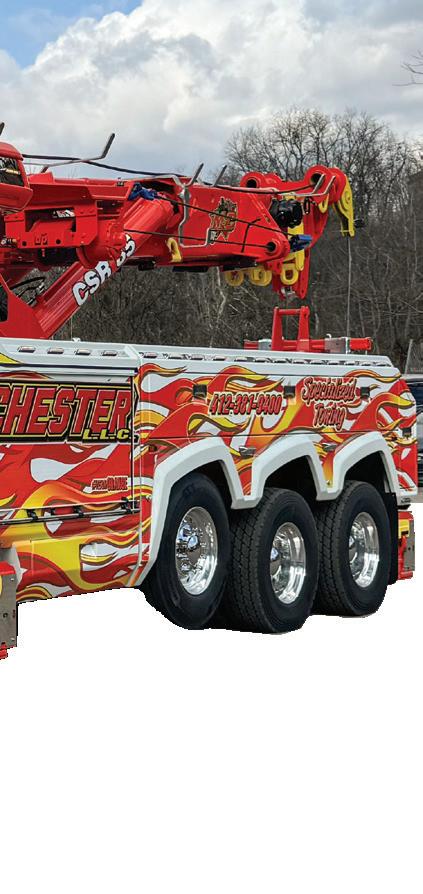
Custom Features: vinyl wrap, toolboxes, front bumper, visor, extra lighting and chrome accents


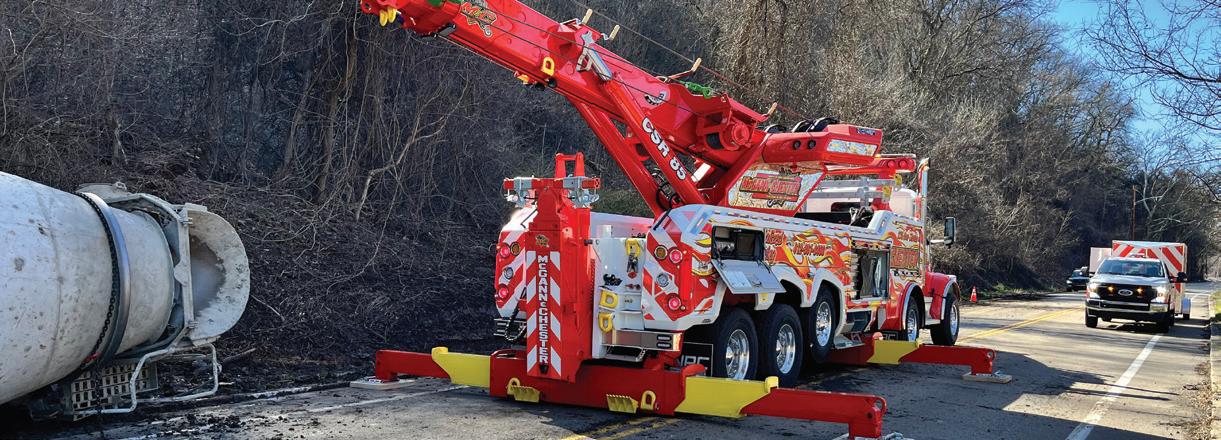



up, however, it wasn’t decorated or customized, and it took about a month of effort to get it ready for service. Applying the colorful wrap was the son of one of McGann & Chester’s employees, who also does work for NASCAR. The striking graphics match that of many other vehicles in the firm’s fleet, amounting to about 100 in all. That was just part of the prep work, though.
As Bob also pointed out, “We customize our tool boxes,” with help from Matt Zelinsky, Operations Manager of Null’s Sales and Service. Since the NRC’s outriggers use a solid and sturdy crossbeam, they sometimes require cribbing to level up the rotator on uneven surfaces. The wooden cribbing is all neatly stacked in the toolboxes, with canvas straps attached for quick identification and handling. In addition, chains,
straps and other rigging are color coded and hung with care (just like Xmas decorations).
Bob has had other NRC wreckers in the past, and currently has a 20TB, 40CS, and 50CS, along with the CSR85 model shown here.
“Each one has something they’re good at,” Bob notes. On this latest rotator, the detachable underlift allows the boom to slide all the way aft for closer access to casualty vehicles. He adds that the pins and quickdisconnect hoses on the underlift allow for detachment in less than five minutes. This provides some versatility since most of the jobs the rotator handles are recoveries rather than straight tows.
So, what’s in the works for next Xmas? “You never know,” he laughed. But gift-giving is a welcome tradition at McGann & Chester.

 Steve Calitri Editor-in-Chief scalitri@towman.com
Steve Calitri Editor-in-Chief scalitri@towman.com

After the introduction of the driverless car, and now the autonomous truck, naturally I’ve been thinking how and when the autonomous tow operator will be developed. I’m sure you have, too.
Relatively simple tasks of changing flat tires, boosting batteries, and even securing a vehicle to a wheel lift, may be closer to being introduced for trials than we think. But is the delicate task of uprighting a car or truck something a robot could figure out and perform? Can all the various and unique challenges that are tasked to a tow operator be handled by a smart machine?
The programming for the kind of intelligence needed to quickly and accurately evaluate a scene and choose the right approach, and then be able to perform the recovery, would be detailed
and elaborate. A computer nerd would pick the brain of one great recovery veteran, with the goal of making all his brothers and sisters obsolete.
Yet, this could be ten years away from a finished product.
However, the more I thought about this, I realized that the first to be replaced may be the boss himself. The business would then be run, well, like a business. No heart reaching out to the unfortunate car owner. No wasted animosity toward the competitor. No tow-rate schedules based on the current going charge. No illogical business calls. And no more owner-operators who spend too much time on the road.
The AI boss would act like most field generals; stay back to gain the best perspective on the operation, and how it should be run.
Now, this won’t be as bad as it might sound. You could still own the business, but keep out of the way of the new boss calling the shots. If your ego can handle that, it may be the best business decision you will ever make.



Fallen Louisiana Towman Grieved Over and Honored Family and friends of 34-year-old fallen towman Shannon Thibodeaux expressed their grief after they were notified of the tragic circumstances causing his death. Towers honored his life by driving in procession after his funeral.
Thibodeaux, who was a tow operator at R&R Towing Company, was helping a woman with a flat tire on the side of I-49 when he and the customer he was serving were both struck and killed on April 3.

Troy Thibodeaux, the father of Shannon Thibodeaux, cried, “That was my first-born child. He’s been taken from me.” Troy said he was informed about his son after waking up to a loud banging on his door from State Police.
Trevor Guidry, a worker at R & R Towing, remembers his friend: "He was a lovable person, honestly. It's gonna be quiet and dull. It's not going to be what it used to be."
Tow truck drivers from across the state honored him by lining up in a final ride after his funeral. "When one of us falls, it's a brotherhood,” said Dylan Goings, a fellow towman. “It's felt throughout the entire industry,"
R&R Towing company set up a Go Fund Me account to help with funeral expenses and to support the two teenage sons Shannon leaves behind.
Sources: www.klfy.com www.katc.com
The Chattanooga Lookouts will assume a new alternate identity for the 2024 baseball season. The new alternate identity was chosen to recognize Chatta-
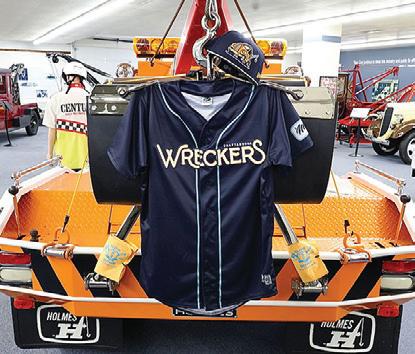
nooga as the birthplace of the Holmes wrecker and to honor the past, present, and future of the towing industry.
For six games the team will play as the Chattanooga Wreckers, featuring new on-field jerseys and hats in a dark navy and orange color scheme. The primary mark features a vintage wrecker in orange inspired by the inventor of the tow hitch, Ernest Holmes Sr. The team is partnering with Miller Industries and the International Towing and Recovery Museum to help shine the spotlight
on the hard-working men and women who work in the towing and recovery industry.
“Having the opportunity to tell the story of a homegrown industry, an industry that was born and built right here in Chattanooga, is a unique opportunity” said Lookouts Vice President Andrew Zito. “The Lookouts and the towing industry have been a staple of Chattanooga for more than 100 years. We are super excited to bring this identity to life throughout our 2024 season.”
The Chattanooga Wreckers, presented by Miller Industries, will play Sunday, June 16, Friday July 12, Saturday, August 3, and Thursday, August 29. Wreckers’ games will also feature special entertainment, promotions and yes, tow trucks.
“Miller Industries is thrilled to partner with the Lookouts,” said Miller Industries Vice President of Marketing Kipp Felice. “With Chattanooga being the birthplace of towing, and home of The World’s Largest Manufacturer
of Towing and Recovery Equipment, Miller Industries, we knew we needed to be a part of this and are very proud to be the presenting partner of the Chattanooga Wreckers. We look forward to working alongside the International Towing and Recovery Museum and the Lookouts to highlight and share the history of our industry.”
Source: Miller Industries Press Release
Michigan tow truck driver Keagan Spencer, who was struck and killed on a highway median trying to rescue a dog in November, 2023. Since then, his father, Matt Spencer, a second-generation towman, has been pushing hard to promote move over awareness and highway safety.
His latest efforts include working with Michigan legislators to sponsor a bill to change the name of
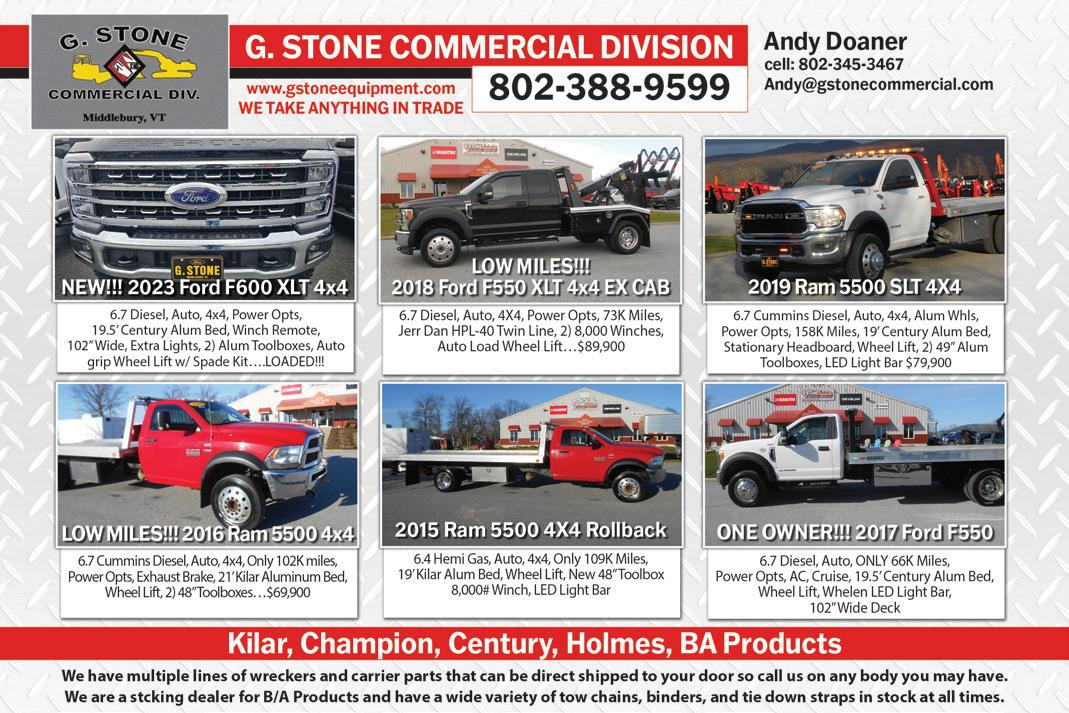
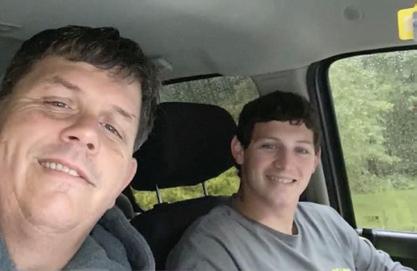
a memorial highway to the “Keagan Spencer Memorial Highway.” House Bill 5552 would designate a section of highway as a memorial to honor his son Keagan.
“Fellow towers want to put some type of memorial up, and this is going to be his memorial,” said Matthew Spencer, Keagan Spencer’s father.
Since the crash, the tow truck community, along with Keagan Spencer’s father, have worked with politicians to raise awareness on stricter laws when it comes to drivers and tow trucks.
“There’s some bills that are introduced,” said Matthew. “Right now, Representative Gina Johnsen has in-
troduced ‘Keagan’s Law,’ which is to clean up some of the verbiage in the move-over laws, but the biggest thing is allowing tow trucks to turn the blue emergency flashing lights on our vehicles,” he added.
Source: woodtv.com
Iowa tow truck driver Granvell Kelly Ramey, 52, was arrested and booked, after allegedly texting and driving recklessly and injuring a woman at an intersection. He was charged with one count each of serious injury by vehicle and leaving the scene of an injury accident.
Ramey was issued 10 citations for numerous traffic offenses including running stop signs, driving with no hands while using an electronic device and not wearing a seatbelt, among other offenses.
Ramey was implicated as surveillance video from nearby busi-

nesses identified a 2016 Freightliner tow truck, which was found in a nearby tow yard. The tow truck was equipped with two cameras, one that faced out of the front windshield onto the roadway, and another facing the driver in the cab. Ramey was identified as the driver of the tow truck by the video from the cab and by co-workers, according to the affidavit. He also admitted to driving the truck.
Ramey was released from the county jail after posting 10% of the $5,000 bond through a bonding company.
Source: qctimes.com

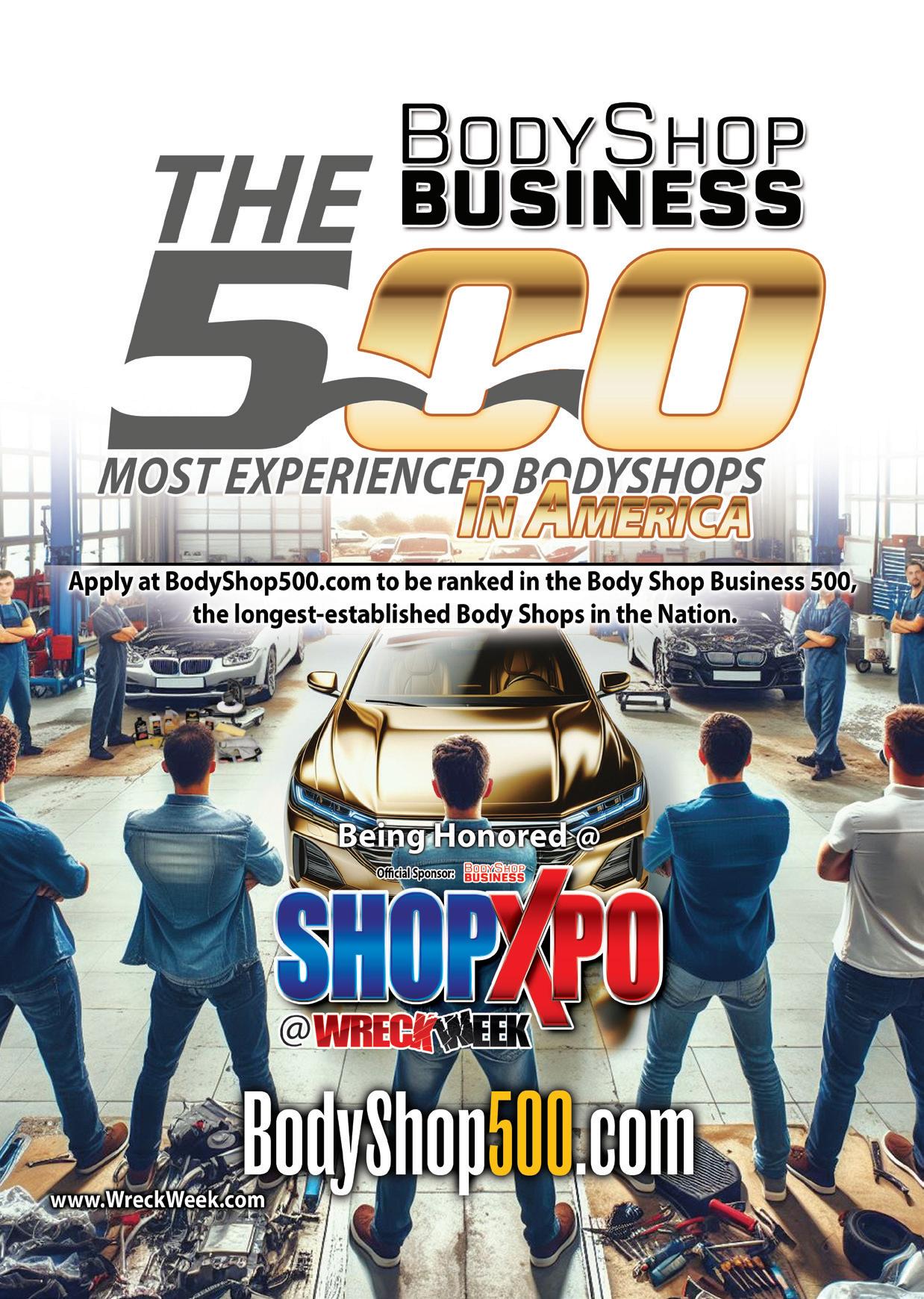




Family and friends of 34-year-old fallen towman Shannon Thibodeaux expressed their grief after they were notified of the tragic circumstances causing his death. Towers honored his life by driving in procession after his funeral.

Thibodeaux, who was a tow operator at R&R Towing Company, was helping a woman with a flat tire on the side of I-49 when he and the customer he was serving were both struck and killed on April 3.
Troy Thibodeaux, the father of Shannon Thibodeaux, cried, “That was my first-born child. He’s been taken from me.” Troy said he was informed about his son after waking up to a loud banging on his door from State Police.
Trevor Guidry, a worker at R & R Towing, remembers his friend: “He was a lovable person, honestly. It’s gonna be quiet and dull. It’s not going to be what it used to be.”
Tow truck drivers from across the state honored him by lining up in a final ride after his funeral. “When one of us falls, it’s a brotherhood,” said Dylan Goings, a fellow towman. “It’s felt throughout the entire industry,”
R&R Towing company set up a Go Fund Me account to help with funeral expenses and to support the two teenage sons Shannon leaves behind.
Sources: www.klfy.com www.katc.com


attire is now available for purchase online at Lookouts.com.
The Chattanooga Lookouts will assume a new alternate identity for the 2024 baseball season. The new alternate identity was chosen to recognize Chattanooga as the birthplace of the Holmes wrecker and to honor the past, present, and future of the towing industry.
For six games the team will play as the Chattanooga Wreckers, featuring new on-field jerseys and hats in a dark navy and orange color scheme. The primary mark features a vintage wrecker in orange inspired by the inventor of the tow hitch, Ernest Holmes Sr. The team is partnering with Miller Industries and the International Towing and Recovery Museum to help shine the spotlight on the hard-working men and women who work in the towing and recovery industry.
“Having the opportunity to tell the story of a homegrown industry, an industry that was born and built right here in Chattanooga, is a unique opportunity” said Lookouts Vice President Andrew Zito. “The Lookouts and the towing industry have been a staple of Chattanooga for more than 100 years. We are super excited to bring this identity to life throughout our 2024 season.”
The Chattanooga Wreckers, presented by Miller Industries, will play Sunday, June 16, Friday July 12, Saturday, August 3, and Thursday, August 29. Wreckers’ games will also feature special entertainment, promotions and yes, tow trucks.
“Miller Industries is thrilled to partner with the Lookouts,” said Miller Industries Vice President of Marketing Kipp Felice. “With Chattanooga being the birthplace of towing, and home of The World’s Largest Manufacturer of Towing and Recovery Equipment, Miller Industries, we knew we needed to be a part of this and are very proud to be the presenting partner of the Chattanooga Wreckers. We look forward to working alongside the International Towing and Recovery Museum and the Lookouts to highlight and share the history of our industry.”
Source: Miller Industries Press Release

Michigan tow truck driver Keagan Spencer, who was struck and killed on a highway median trying to rescue a dog in November, 2023. Since then, his father, Matt Spencer, a second-generation towman, has been pushing hard to promote move over awareness and highway safety.
His latest efforts include working with Michigan legislators to sponsor a bill to change the name of a memorial highway to the “Keagan Spencer Memorial Highway.” House Bill 5552 would designate a section of highway as a memorial to honor his son Keagan.
Since the crash, the tow truck community, along with Keagan Spencer’s father, have worked with politicians to raise awareness on stricter laws when it comes to drivers and tow trucks.
“There’s some bills that are introduced,” said Matthew. “Right now, Representative Gina Johnsen has introduced ‘Keagan’s Law,’ which is to clean up some of the verbiage in the move-over laws, but the biggest thing is allowing tow trucks to turn the blue emergency flashing lights on our vehicles,” he added.
Source: woodtv.com
Iowa tow truck driver Granvell Kelly Ramey, 52, was arrested and booked, after allegedly texting and driving recklessly and injuring a woman at an intersection. He was charged with one count each of serious injury by vehicle and leaving the scene of an injury accident.
Ramey was issued 10 citations for numerous traffic offenses including running stop signs, driving with no hands while using an electronic device and not wearing a seatbelt, among other offenses.

“Fellow towers want to put some type of memorial up, and this is going to be his memorial,” said Matthew Spencer, Keagan Spencer’s father.
Ramey was implicated as surveillance video from nearby businesses identified a 2016 Freightliner tow truck, which was found in a nearby tow yard. The tow truck was equipped with two cameras, one that faced out of the front windshield onto the roadway, and another facing the driver in the cab. Ramey was identified as the driver of the tow truck by the video from the cab and by co-workers, according to the affidavit. He also admitted to driving the truck.
Ramey was released from the
county jail after posting 10% of the $5,000 bond through a bonding company.
Source: qctimes.com

A Pennsylvania bill would require Philadelphia towing companies to photograph the cars, and signage that spurred their removal. The photo must be provided to the car’s owner before receiving payment to release the vehicle.
The bill stems from complaints from motorists who must pay hundreds of dollars to get their car back without a satisfactory explanation as to why their vehicle was moved.
“We’ve had this problem for years,” said Representative Jose Giral, who introduced the bill. “Constituents feel they were wrongly towed and felt no way to file an appeal. This is able to give them some proof.”
The bill would only apply in Philadelphia, and would give the Philadelphia Parking Authority oversight and enforcement duties.
Source: phillytrib.com
The aftereffects of the Superfog pile-up that transpired last October continue to reverberate, as a Louisiana truck driver was charged with negligent homicide for his role in the crash that left eight dead last year.
Ronald Britt was operating a truck at unsafe speeds on Interstate 55 west of New Orleans when he slammed into the back of a car that had stopped in the left lane be-
hind several other vehicles involved in minor crashes, Louisiana State Police said in a statement Tuesday. That collision killed 60-year-old James Fleming and seriously injured his wife.
Britt, a 61-year-old commercial truck driver, was arrested on multiple charges, including negligent homicide, negligent injuring, reckless operation and other traffic-related offenses, state police said. Britt voluntarily surrendered to authorities.
Source: nbcnews.com

Memphis Tennessee tow company A1 Towing and Hauling, which operates under a number of assumed names, was sued by three trucking companies for $5 million dollars over predatory towing and other allegations.
Western Express Inc., MHT Group Inc., and Church Transportation and Logistics filed the civil suit in the U.S. District Court for the Western District of Tennessee. It accuses A1’s Towing and S-Line Parking of preying on commercial truck drivers in violation of the federal anti-racketeering act, RICO.
The suit charges that A1 Towing and Hauling “engaged in a conspiratorial enterprise in direct violation of multiple local, state, and federal laws.” Also, the towing company “predatorily lured and entrapped commercial truck drivers and their vehicles.”
Furthermore, the suit alleges that, “through the use of both the threat of and at times the actual use of unlawful force, subsequently proceeded to illegally harass, intimidate, assault, batter, hijack, and/or hold hostage plaintiffs’ vehicles, property, and/ or plaintiffs’ employees/agents until plaintiffs paid as ransom to the defendants exorbitant and unlawful ‘debts’ for their release.”
The defendants are also accused of fraud, wire fraud, interfering and violating Tennessee towing statutes and the Tennessee Booting Consumer Protecting Act, and interfering with commerce by threat or violence.
Source: truckinginfo.com








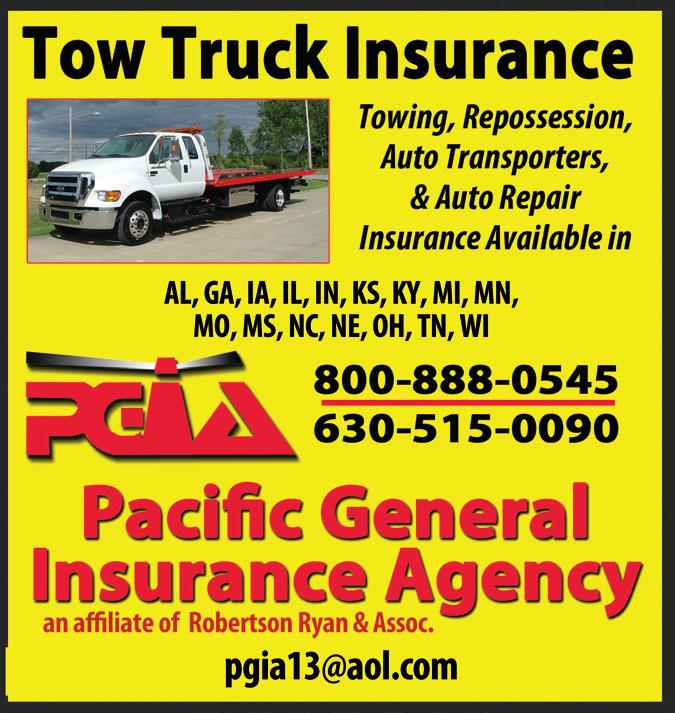
Family and friends of 34-year-old fallen towman Shannon Thibodeaux expressed their grief after they were notified of the tragic circumstances causing his death. Towers honored his life by driving in procession after his funeral.
Thibodeaux, who was a tow operator at R&R Towing Company, was helping a woman with a flat tire on the side of I-49 when he and the customer he was serving were both struck and killed on April 3.

Troy Thibodeaux, the father of Shannon Thibodeaux, cried, “That was my first-born child. He’s been taken from me.” Troy said he was informed about his son after waking up to a loud banging on his door from State Police.
Trevor Guidry, a worker at R & R Towing, remembers his friend: “He was a lovable person, honestly. It’s gonna be quiet and dull. It’s not going to be what it used to be.”
Tow truck drivers from across the state honored him by lining up in a final ride after his funeral. “When one of us falls, it’s a brotherhood,” said Dylan Goings, a fellow towman. “It’s felt throughout the entire industry,”
R&R Towing company set up a Go Fund Me account to help with funeral expenses and to support the two teenage sons Shannon leaves behind.
Sources: www.klfy.com www.katc.com
The Chattanooga Lookouts will assume a new alternate identity for the 2024 baseball season. The new alternate identity was chosen to recog-

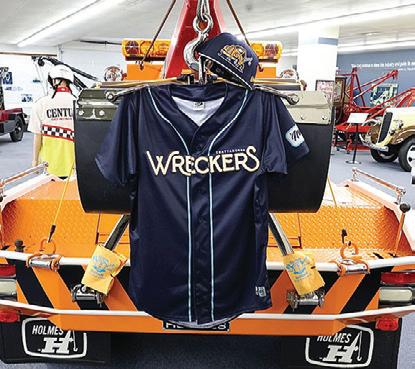
nize Chattanooga as the birthplace of the Holmes wrecker and to honor the past, present, and future of the towing industry.
For six games the team will play as the Chattanooga Wreckers, featuring new on-field jerseys and hats in a dark navy and orange color scheme. The primary mark features a vintage wrecker in orange inspired by the inventor of the tow hitch, Ernest Holmes Sr. The team is partnering with Miller Industries and the
International Towing and Recovery Museum to help shine the spotlight on the hard-working men and women who work in the towing and recovery industry.
“Having the opportunity to tell the story of a homegrown industry, an industry that was born and built right here in Chattanooga, is a unique opportunity” said Lookouts Vice President Andrew Zito. “The Lookouts and the towing industry have been a staple of Chattanooga for more than 100 years. We are super excited to bring this identity to life throughout our 2024 season.”
The Chattanooga Wreckers, presented by Miller Industries, will play Sunday, June 16, Friday July 12, Saturday, August 3, and Thursday, August 29. Wreckers’ games will also feature special entertainment, promotions and yes, tow trucks.
“Miller Industries is thrilled to partner with the Lookouts,” said Miller Industries Vice President of Marketing Kipp Felice. “With Chattanooga

being the birthplace of towing, and home of The World’s Largest Manufacturer of Towing and Recovery Equipment, Miller Industries, we knew we needed to be a part of this and are very proud to be the presenting partner of the Chattanooga Wreckers. We look forward to working alongside the International Towing and Recovery Museum and the Lookouts to highlight and share the history of our industry.”
Source: Miller Industries Press Release
Michigan tow truck driver Keagan Spencer, who was struck and killed on a highway median trying to rescue a dog in November, 2023. Since then, his father, Matt Spencer, a second-generation towman, has been pushing hard to promote move over awareness and highway safety.
His latest efforts include working with Michigan legislators to sponsor a bill to change the name of a memorial highway to the “Keagan Spencer Memorial Highway.” House Bill 5552 would designate a section of highway as a memorial to honor his son Keagan.
“Fellow towers want to put some type of memorial up, and this is going to be his memorial,” said Matthew Spencer, Keagan Spencer’s father.
Since the crash, the tow truck community, along with Keagan Spencer’s father, have worked with politicians to raise awareness on stricter laws when it comes to drivers and tow trucks.
“There’s some bills that are introduced,” said Matthew. “Right now, Representative Gina Johnsen has introduced ‘Keagan’s Law,’ which is to clean up some of the verbiage in the move-over laws, but the biggest thing is allowing tow trucks to turn the blue emergency flashing lights on our vehicles,” he added.
Source: woodtv.com




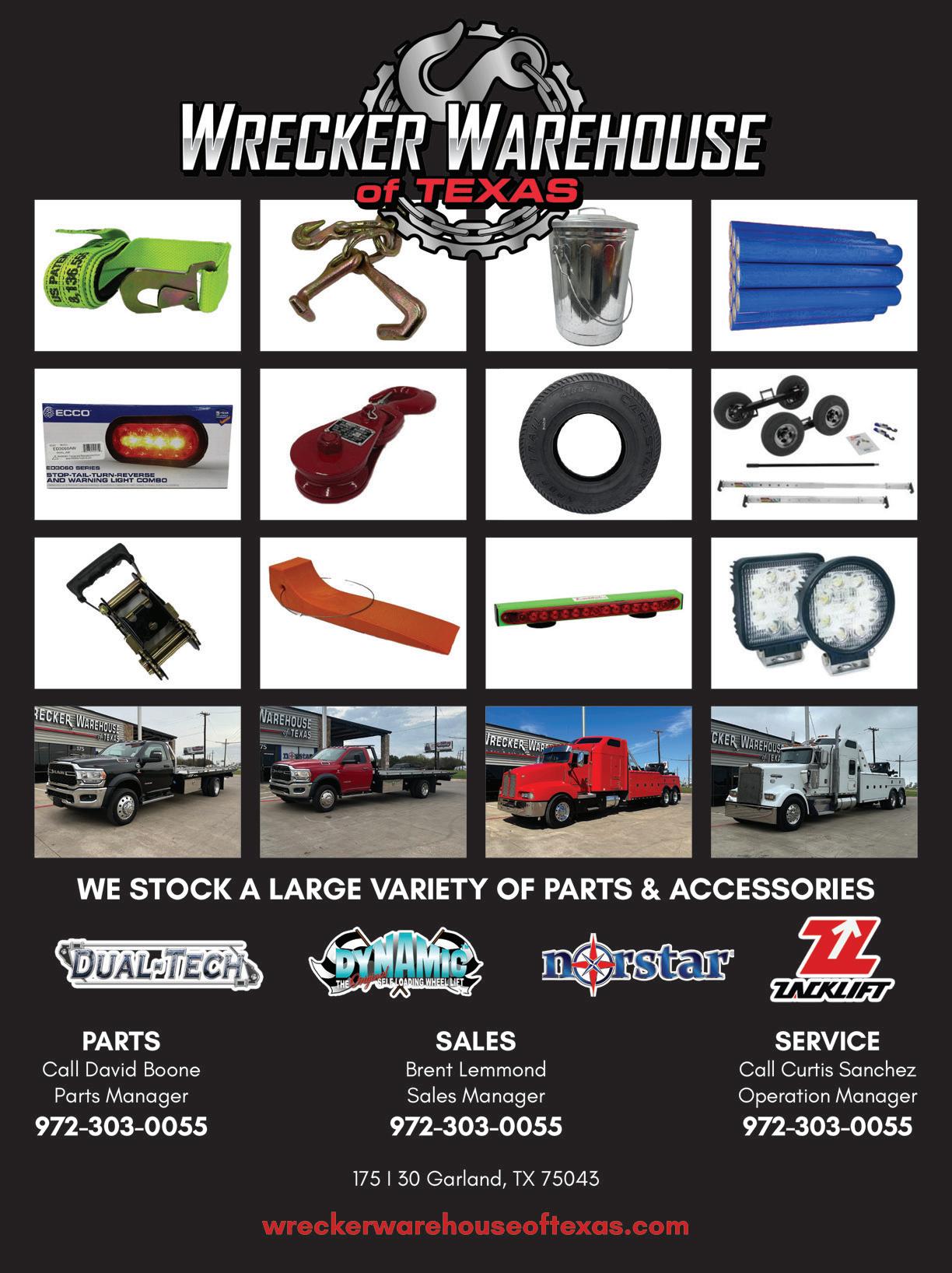


Family and friends of 34-year-old fallen towman Shannon Thibodeaux expressed their grief after they were notified of the tragic circumstances causing his death. Towers honored his life by driving in procession after his funeral.
Thibodeaux, who was a tow operator at R&R Towing Company, was helping a woman with a flat tire on the side of I-49 when he and the customer he was serving were both struck and killed on April 3.
Troy Thibodeaux, the father of Shannon Thibodeaux, cried, “That was my first-born child. He’s been taken from me.” Troy said he was informed about his son after waking up to a loud banging on his door from State Police.
Trevor Guidry, a worker at R & R Towing, remembers his friend: “He was a lovable person, honestly. It’s gonna be quiet and dull. It’s not going to be what it used to be.”
Tow truck drivers from across the state honored him by lining up in a final ride after his funeral. “When one of us falls, it’s a brotherhood,” said Dylan Goings, a fellow towman. “It’s felt throughout the entire industry,”
R&R Towing company set up a Go Fund Me account to help with funeral expenses and to support the two teenage sons Shannon leaves behind.
Sources: www.klfy.com www.katc.com
The Chattanooga Lookouts will assume a new alternate identity for the 2024 baseball season. The new alternate identity was chosen to recognize Chattanooga as the birthplace of the Holmes wrecker and to honor the past, present, and future of the towing industry.
For six games the team will play as the Chattanooga Wreckers, featuring new onfield jerseys and hats in a dark navy and orange color scheme. The primary mark features a vintage wrecker in orange inspired by the inventor of the tow hitch, Ernest Holmes Sr. The team is partnering
◀

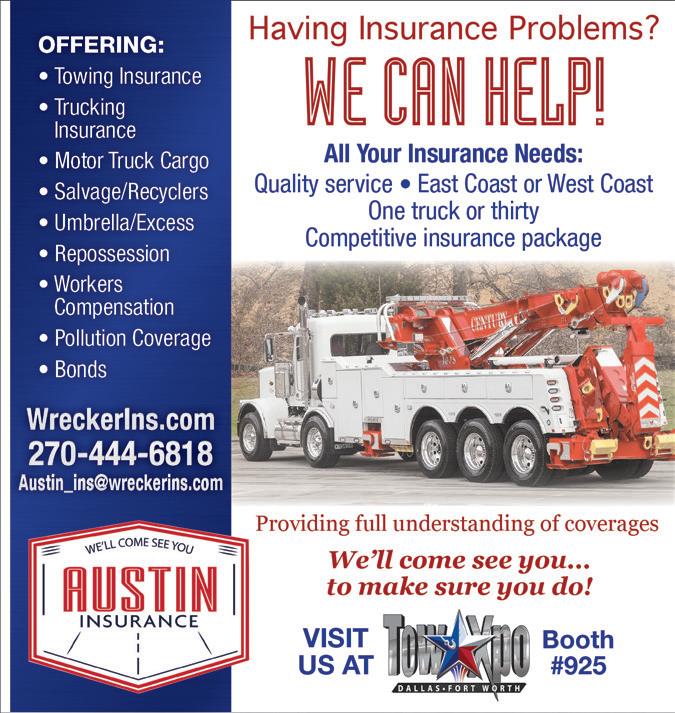

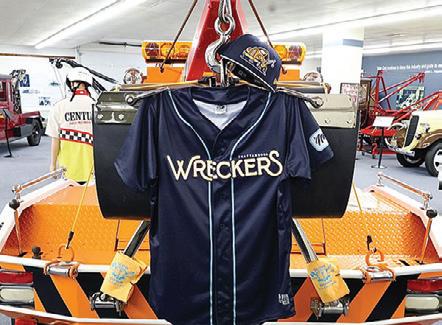
with Miller Industries and the International Towing and Recovery Museum to help shine the spotlight on the hard-working men and women who work in the towing and recovery industry.
“Having the opportunity to tell the story of a homegrown industry, an industry that was born and built right here in Chattanooga, is a unique opportunity” said Lookouts Vice President Andrew Zito. “The Lookouts and the towing industry have been a staple of Chattanooga for more than 100 years. We are super excited to bring this identity to life throughout our 2024 season.”
The Chattanooga Wreckers, presented by Miller Industries, will play Sunday, June 16, Friday July 12, Saturday, August 3, and Thursday, August 29. Wreckers’ games will also feature special entertainment, promotions and yes, tow trucks.
“Miller Industries is thrilled to partner with the Lookouts,” said Miller Industries Vice President of Marketing Kipp Felice. “With Chattanooga being the birthplace of towing, and home of The World’s Largest Manufacturer of Towing and Recovery Equipment, Miller Industries, we knew we needed to be a part of this and are very proud to be the presenting partner of the Chattanooga Wreckers. We look forward to working alongside the International Towing and Recovery Museum and the Lookouts to highlight and share the history of our industry.”
Source: Miller Industries Press Release
Michigan tow truck driver Keagan Spencer, who was struck and killed on a highway median trying to rescue a dog in November, 2023. Since then, his father,

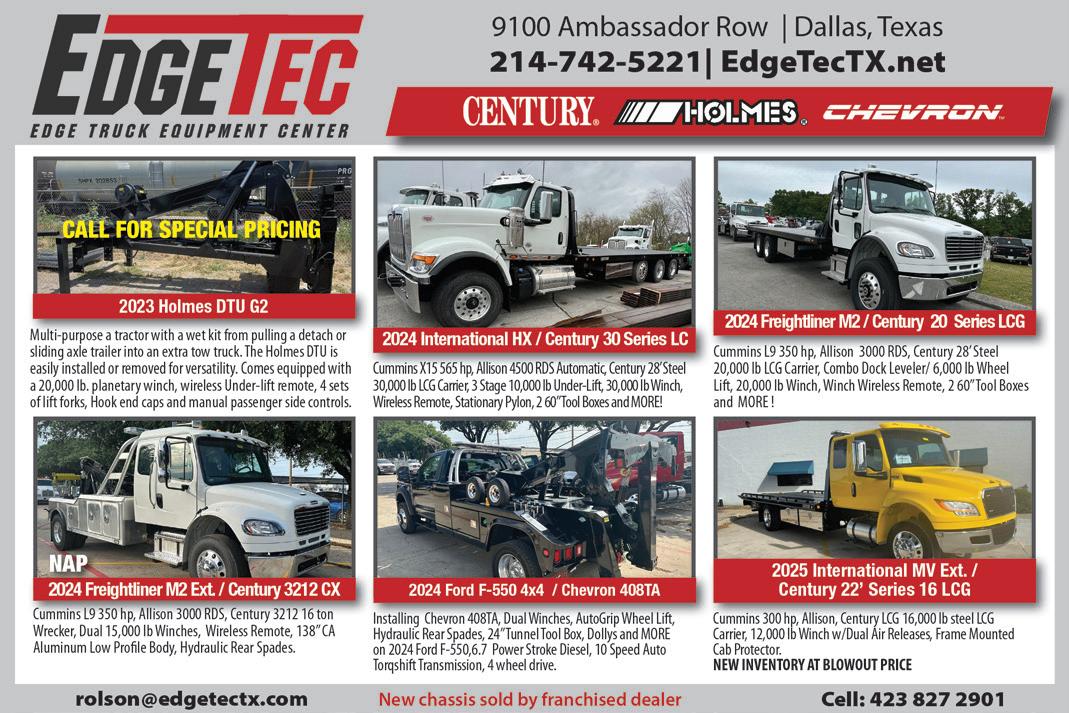

Matt Spencer, a second-generation towman, has been pushing hard to promote move over awareness and highway safety.
His latest efforts include working with Michigan legislators to sponsor a bill to change the name of a memorial highway to the “Keagan Spencer Memorial Highway.” House Bill 5552 would designate a section of highway as a memorial to honor his son Keagan.
“Fellow towers want to put some type of memorial up, and this is going to be his memorial,” said Matthew Spencer, Keagan Spencer’s father.
Since the crash, the tow truck community, along with Keagan Spencer’s father, have worked with politicians to raise awareness on stricter laws when it comes to drivers and tow trucks.
“There’s some bills that are introduced,” said Matthew. “Right now, Representative Gina Johnsen has introduced ‘Keagan’s Law,’ which is to clean up some of the verbiage in the move-over laws, but the biggest thing is allowing tow trucks to turn the blue emergency flashing lights on our vehicles,” he added.
Source: woodtv.com
